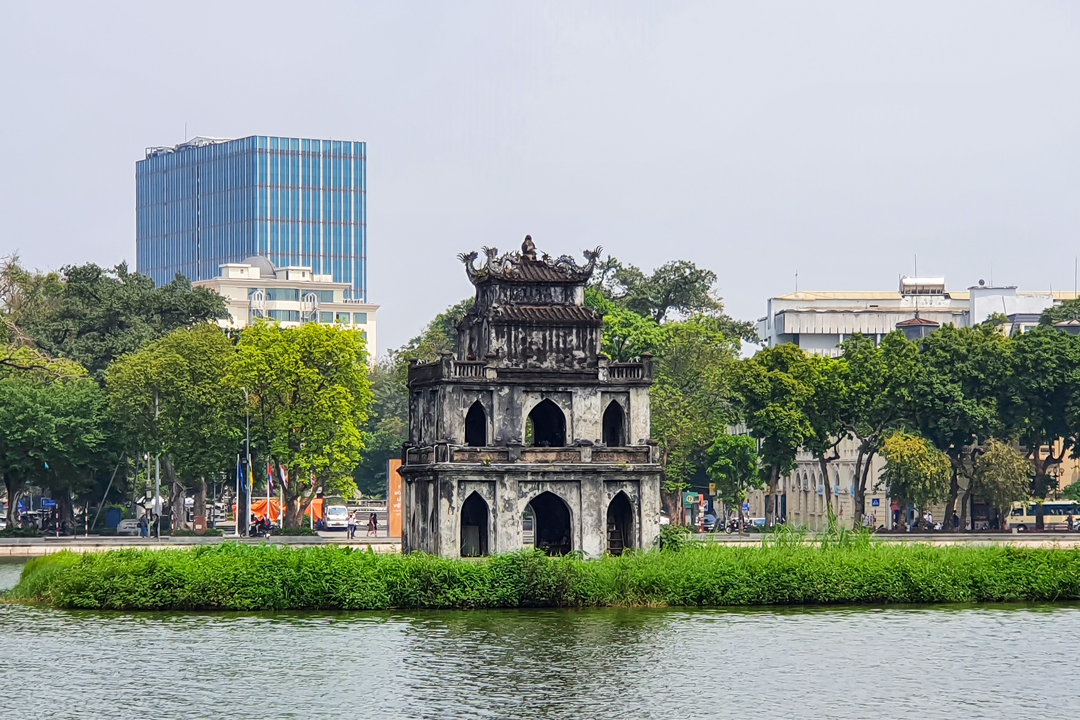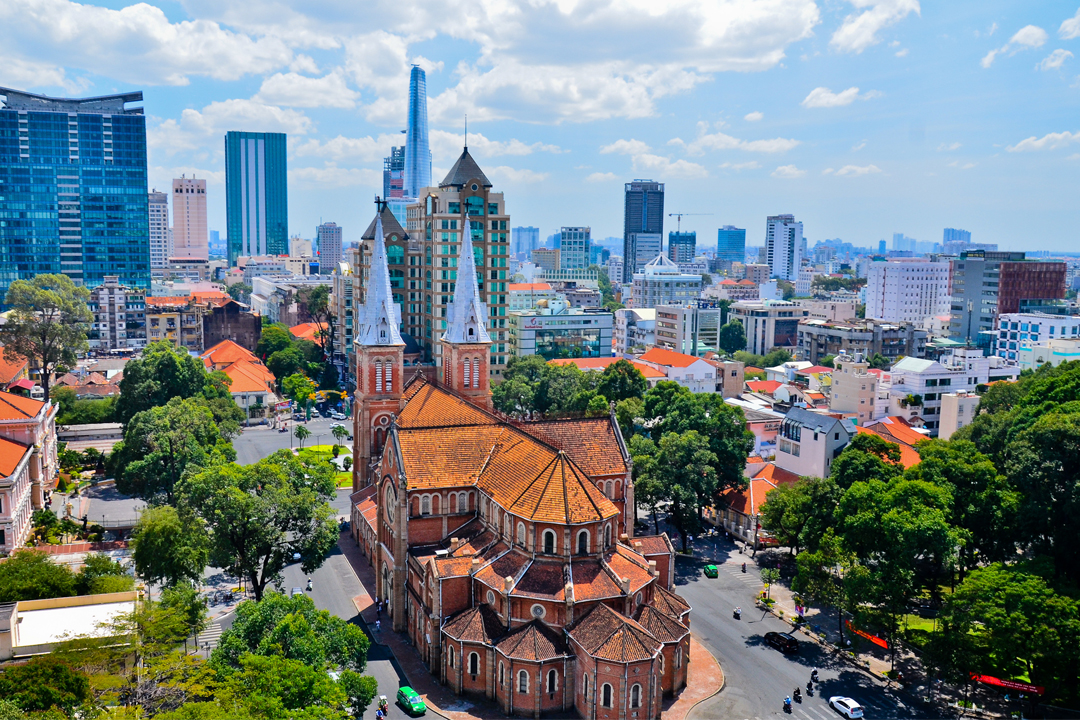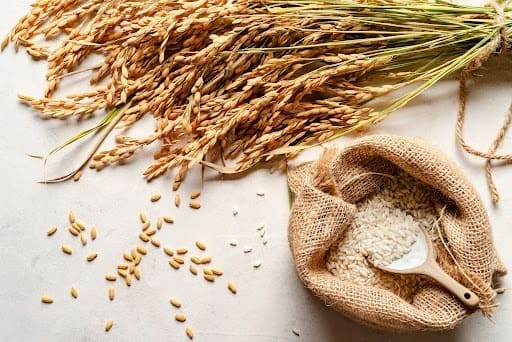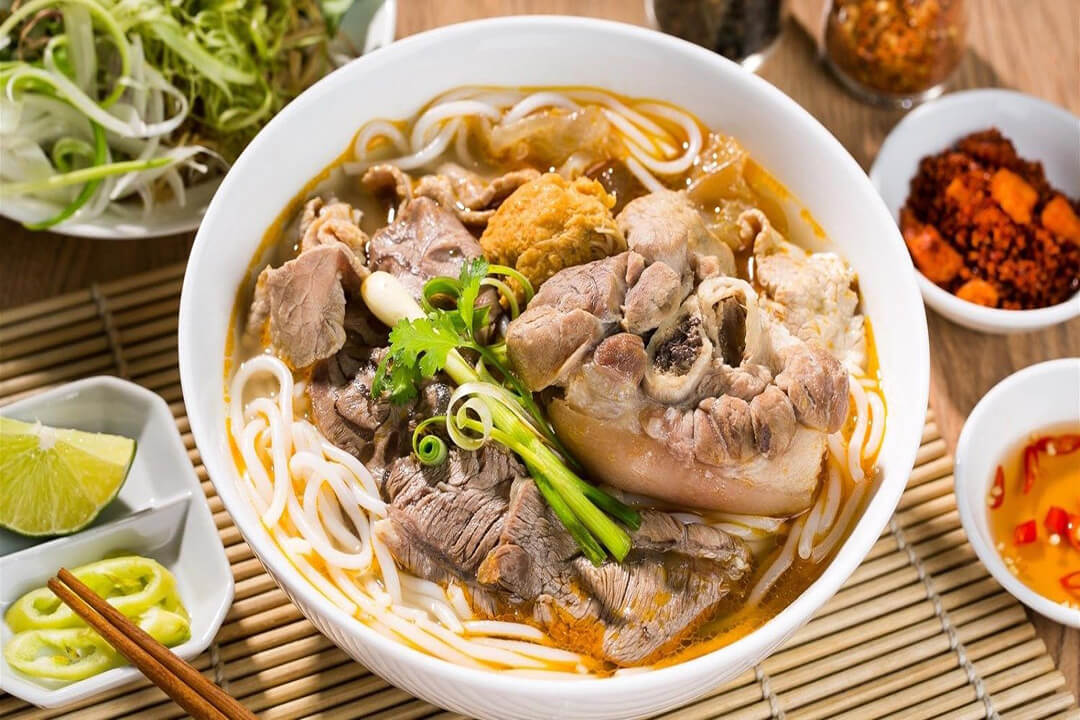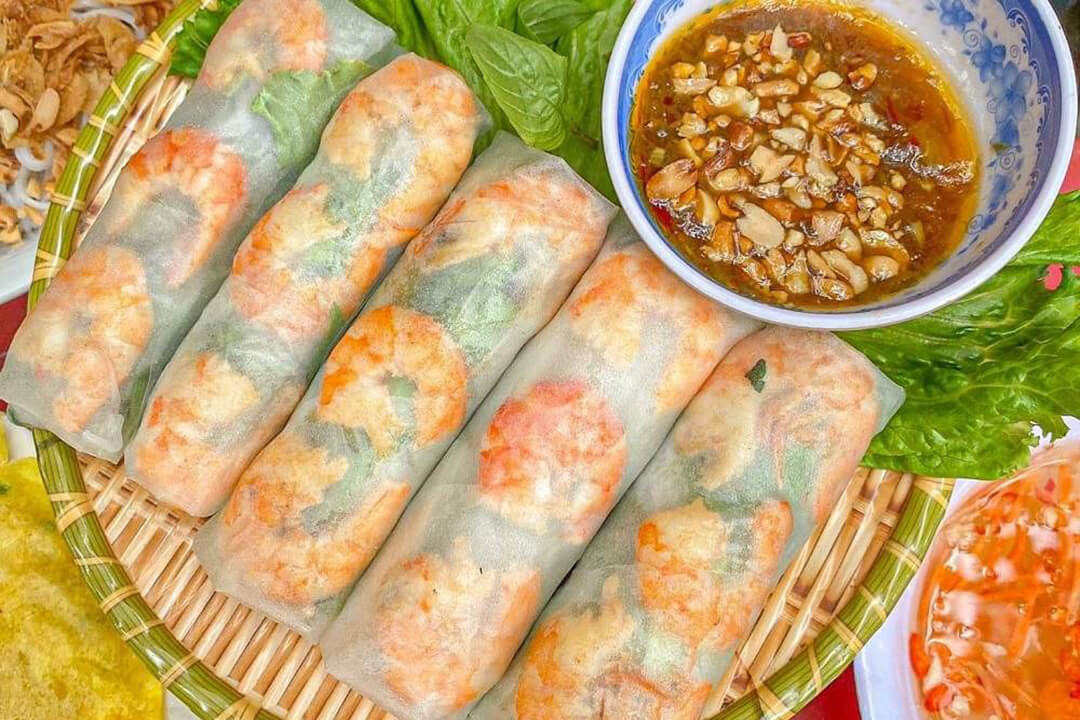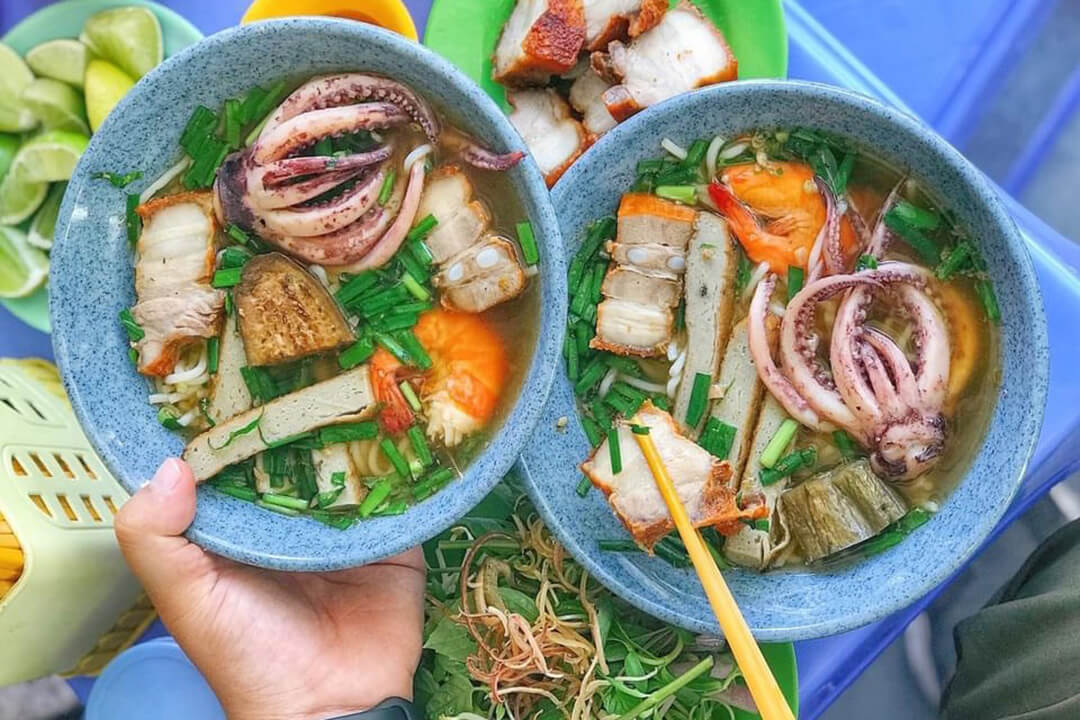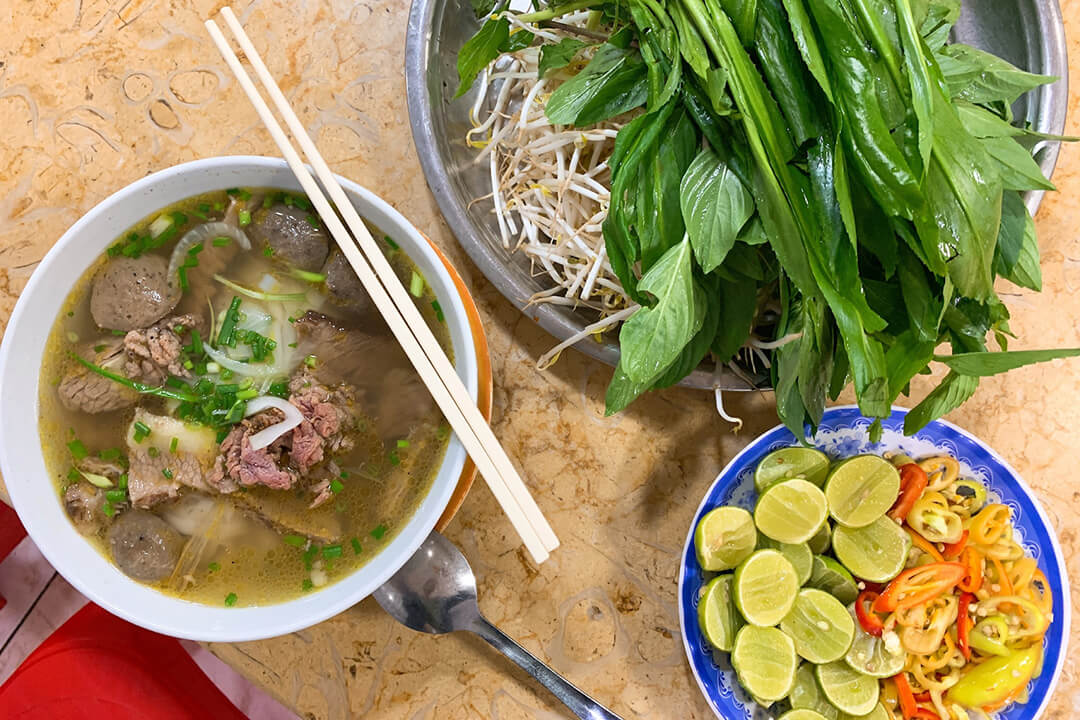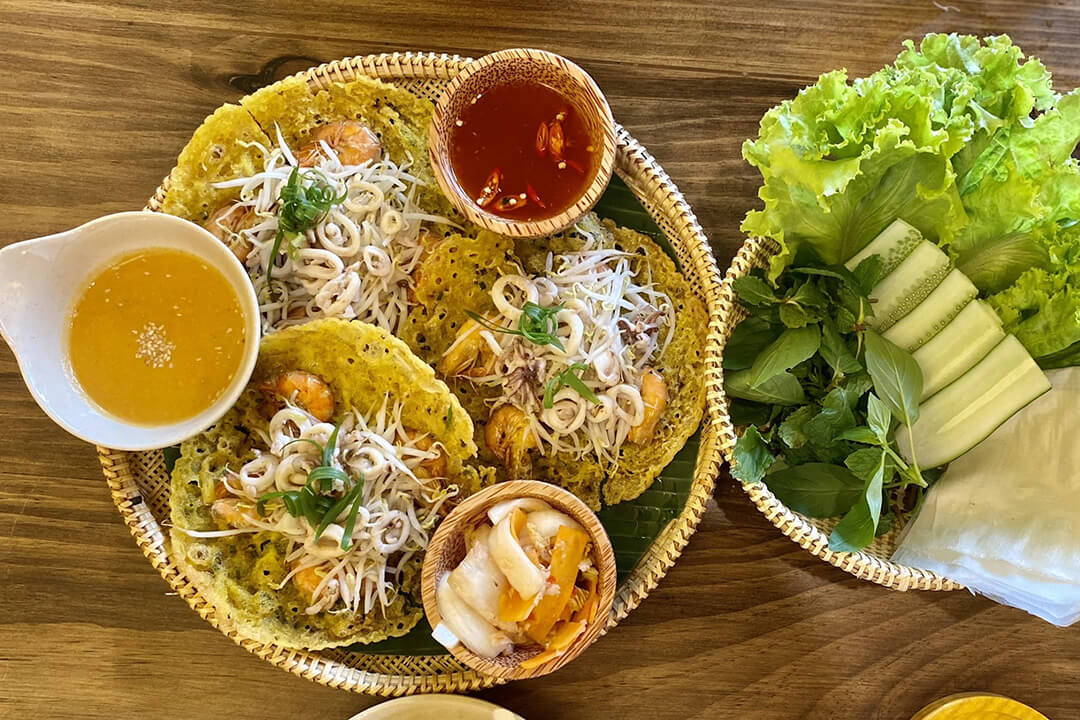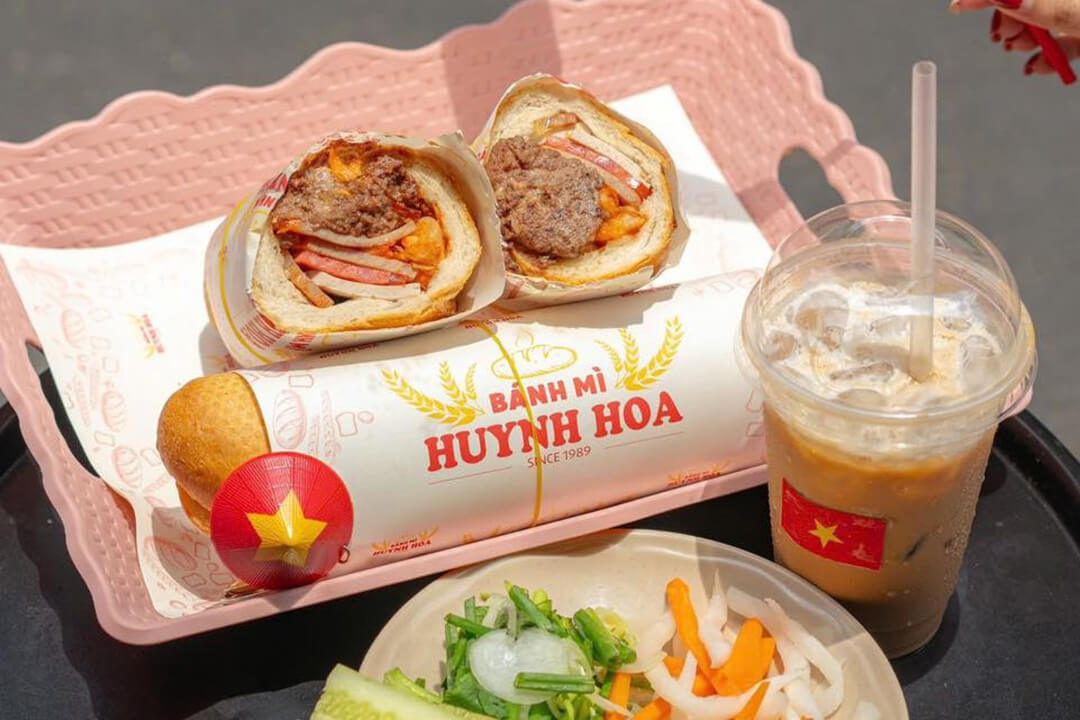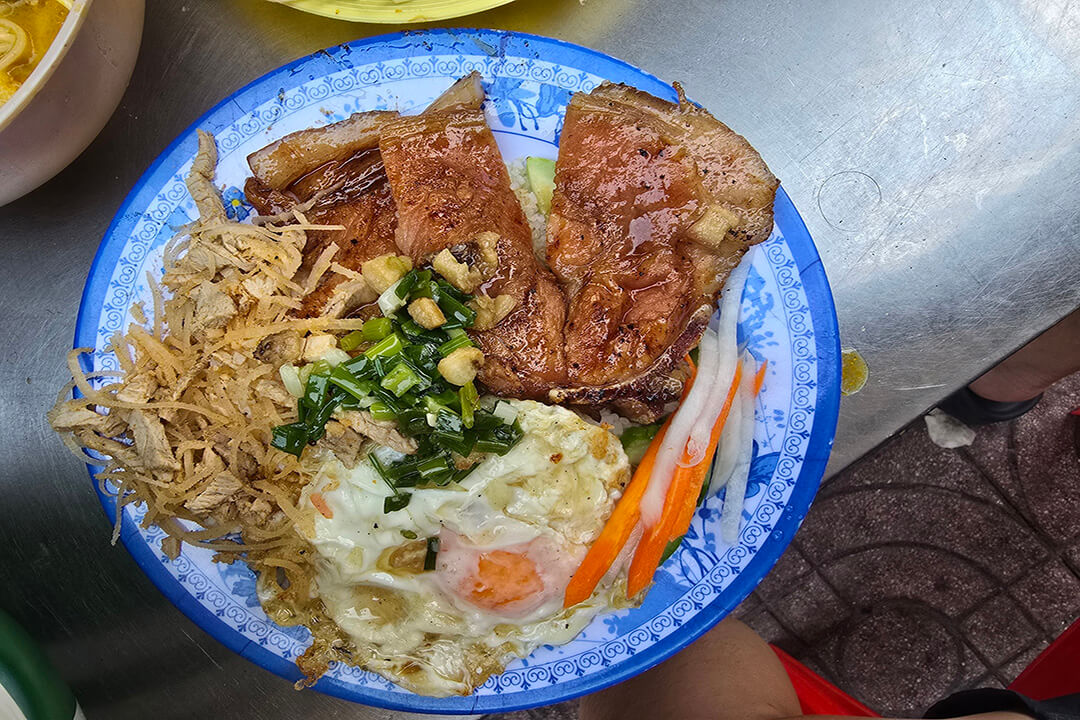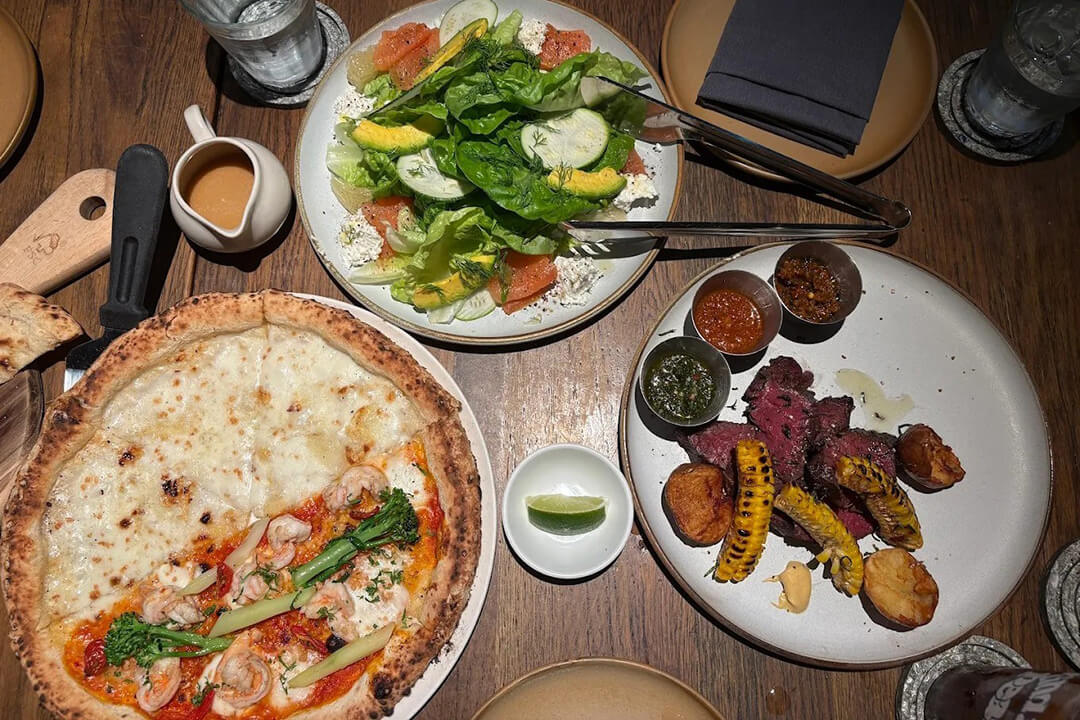Sep - 26 - 2025
The city’s vibrant spirit is reflected not only in its bustling streets but also in its famous foods in Hanoi, with rich flavors simmering in kitchens across the capital. In this guide, GTrip brings you the Top 30 must-try dishes that capture the essence of the capital’s culinary heritage. From iconic street eats to hidden local favorites, each bite is a gateway to discovering Hanoi’s story through taste - one unforgettable dish at a time.
1. Pho (pho bo, pho ga, pho cuon, pho chien phong)
Pho is undoubtedly Hanoi's culinary ambassador to the world. It is a fragrant symphony of clear beef or chicken broth, rice noodles, and fresh herbs that embodies Vietnamese cuisine's delicate balance of flavors. What began as a humble street food in Northern Vietnam has evolved into various creative interpretations while maintaining its soul-nourishing essence. Each steaming bowl offers a perfect harmony of savory broth, tender meat, silky noodles, and aromatic herbs and spices that captivate both locals and visitors alike.
Traditional Vietnamese Pho noodle soup
Pho is the quintessential Vietnamese dish that has conquered taste buds worldwide. The magic lies in its broth, simmered for hours with beef bones or chicken, star anise, cinnamon, cloves, and other aromatic spices. The resulting clear, flavorful liquid is poured over rice noodles and topped with thinly sliced beef (pho bo) or tender chicken (pho ga). Fresh herbs like Thai basil, cilantro, lime wedges, and bean sprouts accompany each bowl, allowing diners to customize their experience.
Authentic pho in Hanoi differs from its southern counterparts with its clearer broth, less garnishes, and more emphasis on the purity of flavor. Locals typically enjoy it for breakfast, believing it provides energy for the day ahead. The dish's simplicity is deceptive, achieving the perfect balance requires generational knowledge and culinary intuition that Hanoi's best pho establishments have mastered.
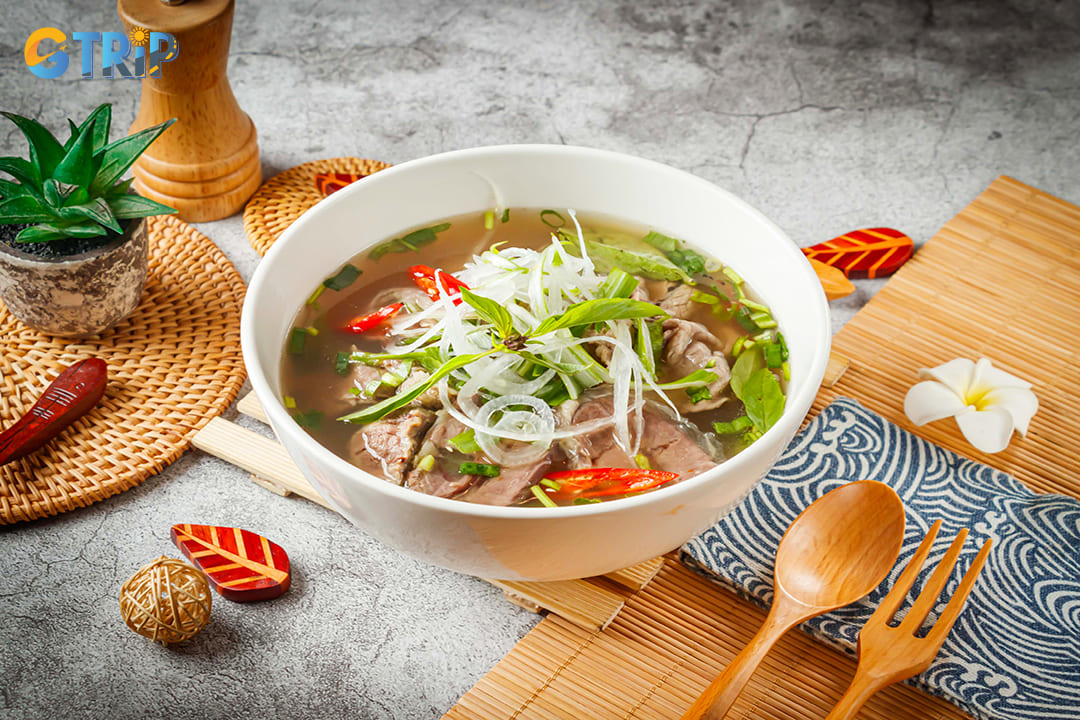
Pho is the quintessential Vietnamese dish that has conquered taste buds worldwide
Recommended places to eat that you should try:
| Restaurant | Address | Price range |
|---|---|---|
| Pho bo Lam | 48 Hang Vai, Hoan Kiem Ward, Hanoi (48 Hang Vai, Hang Bo, Hoan Kiem, Hanoi) | 25,000 - 100,000 VND/bowl ($0.96 - 3.83) |
| Pho ga Cham | 68 Yen Ninh, Ba Dinh Ward, Hanoi (68 Yen Ninh, Truc Bach, Ba Dinh, Hanoi) | 75,000 - 200,000 VND/bowl ($2.87 - 7.66) |
| Pho 10 Ly Quoc Su | 10 Ly Quoc Su, Hoan Kiem Ward, Hanoi (10 Ly Quoc Su, Hang Trong, Hoan Kiem, Hanoi) | 65,000 - 150,000 VND/bowl ($2.49 - 5.75) |
Variations of Pho
Hanoi's culinary creativity shines through its innovative pho variations that have evolved beyond the traditional soup. Pho cuon transforms the classic dish into fresh rice noodle rolls filled with stir-fried beef, herbs, and lettuce, a refreshing alternative perfect for warmer days. The rolls maintain pho's familiar flavors while offering a different textural experience, creating a light yet satisfying meal.
Pho chien phong represents pho's indulgent side, crispy deep-fried rice noodle squares topped with stir-fried beef, vegetables, and a savory gravy. The contrast between the crunchy exterior and the flavorful toppings creates an addictive combination that showcases Vietnamese cuisine's adaptability. These variations demonstrate how Hanoi's food culture honors traditions while embracing innovation, allowing the beloved pho to remain relevant across generations.
Recommended places to eat you should try:
| Restaurant | Address | Price range |
|---|---|---|
| Pho cuon Chinh Thang | No. 7, Mac Dinh Chi, Ba Dinh Ward, Ha Noi (No. 7, Mac Dinh Chi, Truc Bach, Ba Dinh, Ha Noi) | 50,000 - 80,000 VND ($1.92 - 3.06) |
| Pho chien phong | 10 Nguyen Sieu Street, Hoan Kiem Ward, Hanoi (10 Nguyen Sieu Street, Hang Buom Ward, Hoan Kiem District, Hanoi) | 35,000 - 66,000 VND ($1.34 - 2.53) |
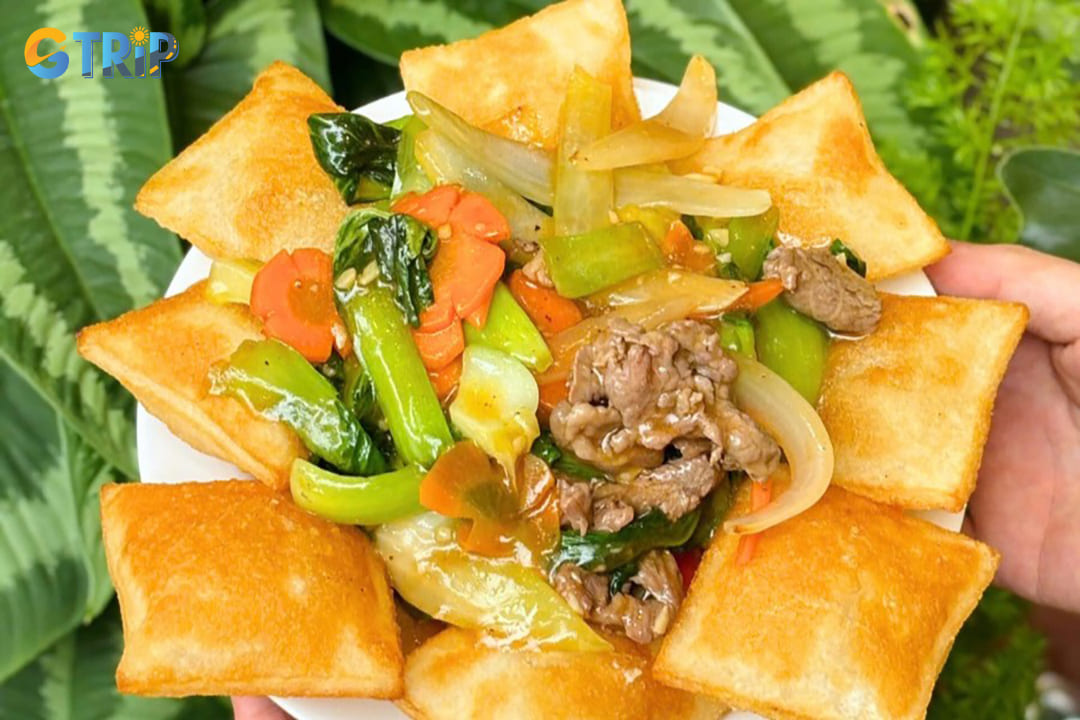
Pho chien phong represents pho's indulgent side, crispy deep-fried rice noodle squares topped with stir-fried beef, vegetables, and a savory gravy
2. Banh mi
Banh mi, Vietnam's iconic sandwich, represents the perfect fusion of French and Vietnamese culinary traditions. This masterpiece consists of a crispy French baguette filled with a harmonious blend of savory meats, fresh herbs, pickled vegetables, and flavorful sauces. In Hanoi, banh mi takes on distinctive local characteristics with variations including pate, grilled pork, Vietnamese ham, or even fried egg. All are enhanced by the crunch of cucumber, cilantro, and the tang of pickled daikon and carrot.
The beauty of banh mi lies in its perfect balance of textures and flavors. The crusty exterior gives way to a soft interior bread, the richness of the meats, the brightness of herbs, and the acidity of pickled vegetables. What began as a French-influenced creation during colonial times has evolved into one of Vietnam's most celebrated street foods and a must-try for any visitor to Hanoi.
Recommended places to eat you should try:
| Restaurant | Address | Price range |
|---|---|---|
| Banh Mi 25 | 25 Hang Ca Street, Hoan Kiem Ward, Hanoi (25 Hang Ca Street, Hang Bo Ward, Hoan Kiem District, Hanoi) | 25,000 - 35,000 VND ($0.96-1.34) |
| Banh Mi Dan To | 32 Tran Nhat Duat Street, Hoan Kiem Ward, Hanoi (32 Tran Nhat Duat Street, Dong Xuan Ward, Hoan Kiem District, Hanoi) | 15,000 - 25,000 VND ($0.57 - 0.96) |
Banh mi represents Hanoi's culinary ingenuity in creating maximum flavor from humble ingredients. The sandwich's portability makes it particularly well-suited for travelers wanting to fuel their explorations without slowing down their sightseeing schedule.

Banh mi, Vietnam's iconic sandwich, represents the perfect fusion of French and Vietnamese culinary traditions
Read more: Top 10 Places for the Best Banh Mi in Hanoi You Must Try
3. Bun dau mam tom
Bun dau mam tom is a beloved Hanoi delicacy featuring fresh rice vermicelli, deep-fried tofu, herbs, and the infamous fermented shrimp paste (mam tom). This hearty dish balances the mild flavors of tofu and noodles with the pungent, complex taste of mam tom that locals adore. Often served with pork, fried fish cakes, and various herbs on a bamboo platter, it represents authentic Hanoian street food culture that challenges adventurous eaters while rewarding them with unforgettable flavors.
The heart of this dish is the mam tom sauce, which foreigners often find challenging at first encounter. Its intense aroma belies a complex umami flavor that, when mixed with lime juice, sugar, and chili, creates a perfect dipping sauce. The crispy golden tofu cubes soak up this sauce beautifully, while the fresh herbs like perilla, Vietnamese balm, and mint provide aromatic contrast. Many locals consider bun dau mam tom the ultimate comfort food, especially during cooler months when the warm components satisfy both hunger and soul.
For first-timers, request "mam tom rieng" (separate fermented shrimp paste) to control your experience, or try it with regular fish sauce if you're hesitant. The true Hanoi experience, however, comes from embracing the full flavor profile with all components mixed together. Each vendor offers slight variations in their mam tom preparation, creating loyal followings for specific establishments throughout the city.
Recommended places to eat you should try:
| Restaurant | Address | Price range |
|---|---|---|
| Bun dau co Tuyen Hang Khay | 27/31 Hang Khay Street, Hoan Kiem Ward, Hanoi (27/31 Hang Khay Street, Trang Tien Ward, Hoan Kiem District, Hanoi) | 45,000 - 65,000 VND ($1.72 - $2.49) |
| Bun dau Met Dong Thai | 11 Dong Thai Street, Hoan Kiem Ward, Hanoi (11 Dong Thai Street, Hang Buom Ward, Hoan Kiem District, Hanoi) | 30,000 - 50,000 VND ($1.15 - $1.92) |
Visit during off-peak hours (before 11:30 AM or after 1:30 PM) to avoid the lunch rush that frequently fills these popular establishments.
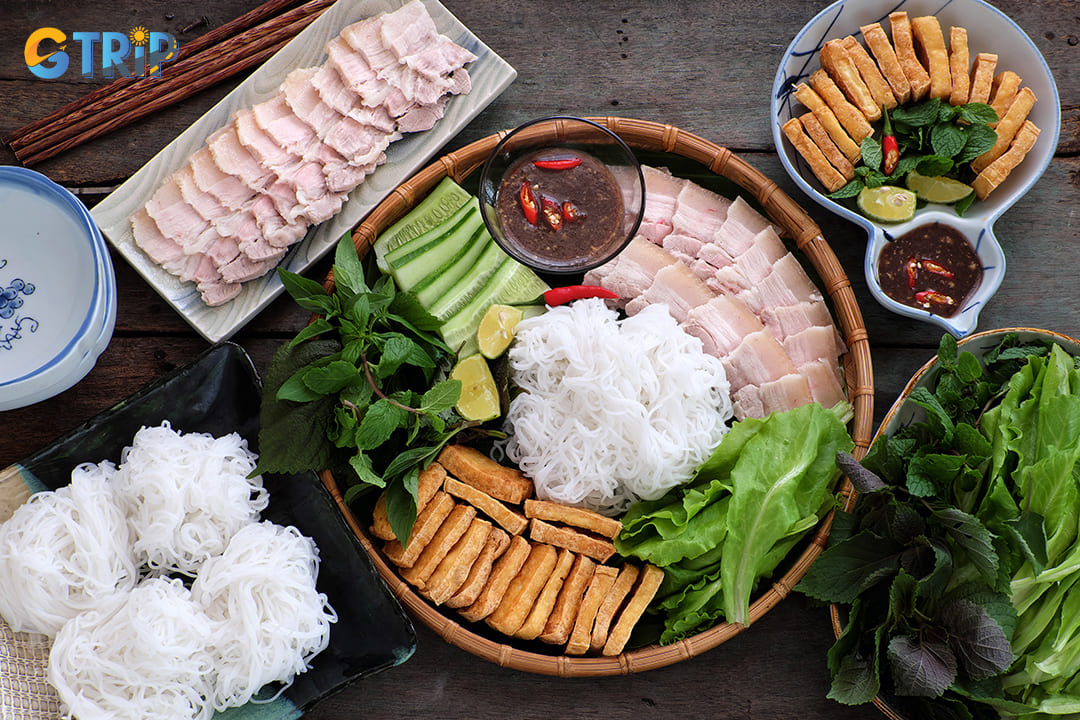
Bun dau mam tom is a beloved Hanoi delicacy featuring fresh rice vermicelli, deep-fried tofu, herbs, and the infamous fermented shrimp paste (mam tom)
4. Bun cha (Grilled pork with vermicelli)
Bun cha is arguably Hanoi's most beloved lunchtime specialty - a dish so iconic that even President Obama sampled it during his visit to Vietnam. This irresistible combination features succulent grilled pork patties and slices of pork belly served in a bowl of sweet-savory fish sauce. It is accompanied by vermicelli rice noodles and a basket of fresh herbs. The smoky aroma of charcoal-grilled meat permeates the streets as vendors fan their grills during the midday rush, creating an authentic culinary experience that captures the essence of Hanoi's food culture.
The beauty of bun cha lies in its customization. Diners assemble each bite by dipping vermicelli into the dipping sauce, adding herbs, and perhaps slipping in a crispy spring roll (nem ran) for textural contrast. The sauce itself is a masterclass in balance, fish sauce mixed with sugar, vinegar, or lime juice, garlic, and chil. It creates a perfect harmony of sweet, sour, salty, and sometimes spicy elements that bring the dish together.
What makes Hanoi's Bun Cha special is the preparation, particularly the grilling technique. The pork patties (cha) are shaped flat and wide to maximize surface area for caramelization, while the belly slices develop charred edges that infuse the dipping broth with smoky complexity. Locals consider Bun Cha a midday meal rather than dinner food, with most authentic vendors closing by late afternoon after selling out of their daily preparations.
Recommended places to eat you should try:
| Restaurant | Address | Price range |
|---|---|---|
| Bun Cha Sinh Tu | 10 Hoang Cau Street, Dong Da Ward, Hanoi (10 Hoang Cau Street, Trung Liet Ward, Dong Da District, Hanoi) | 60,000 - 75,000 VND ($2.30 - 2.87) |
| Bun Cha Que | 15 Ba Trieu Alley, Hai Ba Trung Ward, Hanoi (15 Ba Trieu Alley, Le Dai Hanh Ward, Hai Ba Trung District, Hanoi) | 35,000 - 45,000 VND ($1.34 - 1.72) |
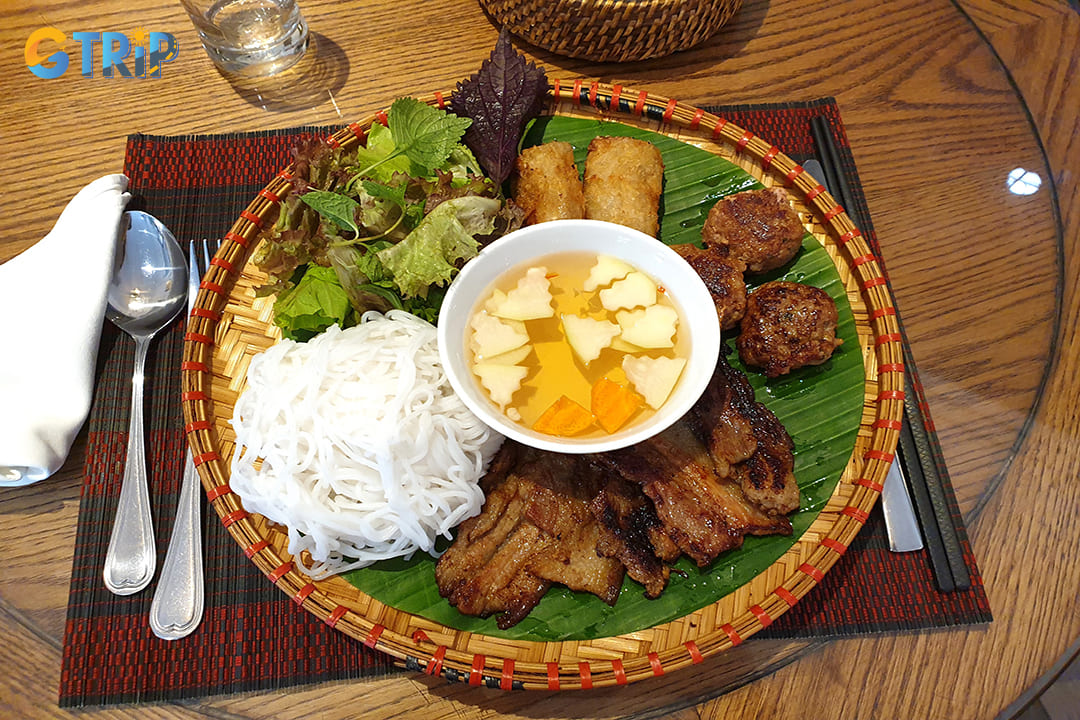
Bun cha features succulent grilled pork patties and slices of pork belly served in a bowl of sweet-savory fish sauce
Read more:
5. Bun rieu (Vietnamese crab noodle soup)
Bun rieu is a tantalizing Vietnamese crab-based noodle soup that captures the essence of Hanoi's culinary traditions. This hearty dish features a distinctive tomato broth colored a vibrant red-orange, rice vermicelli noodles, and pieces of fluffy crab meat mixture (rieu). The complex soup base is traditionally prepared by crushing freshwater crabs to extract their flavorful juices, then combining them with tomatoes, fish sauce, and aromatic herbs. The result is a delicate balance of sweet, sour, and savory notes that has made this dish a beloved staple throughout Northern Vietnam.
In the Hanoi version of bun rieu, the soup is often garnished with fried tofu, fresh herbs, bean sprouts, and a squeeze of lime. What makes this dish particularly special is how it showcases the Vietnamese talent for transforming humble ingredients into something extraordinary. Each spoonful delivers layers of flavor, the tanginess of tomatoes, the sweetness of crab, and the umami depth that can only come from hours of careful preparation. If you want to experience this depth of taste for yourself, explore some of the best bun rieu in Hanoi where tradition and technique shine in every bowl.
Recommended places to try bun rieu in Hanoi:
| Restaurant | Address | Price range |
|---|---|---|
| Bun rieu Tuan Anh | 35-37 Hong Mai Street, Bach Mai Ward, Hanoi (35-37 Hong Mai Street, Bach Mai Ward, Hai Ba Trung District, Hanoi) | 45,000 - 60,000 VND ($1.72 - 2.30) |
| Bun rieu Hang Bo | 57B Hang Bo Street, Hoan Kiem Ward, Hanoi (57B Hang Bo Street, Hang Gai Ward, Hoan Kiem District, Hanoi) | 20,000 - 40,000 VND ($0.77 - 1.53) |
| Bun rieu ganh Hong Phuc (carrying pole) | 18 Hong Phuc Street, Ba Dinh Ward, Hanoi (18 Hong Phuc Street, Truc Bach Ward, Ba Dinh District, Hanoi) | About 40,000 VND ($1.53) |
For the most authentic experience, visit these locations in the morning when the broth is freshest. Locals often add a dash of fermented shrimp paste (mam tom) to enhance the flavor, though this pungent addition might be an acquired taste for visitors. If you're feeling adventurous, try the regional specialty Bun Rieu Oc with added snails, or sample the version served with balut (fertilized duck egg). Both variations showcase how diverse this seemingly simple dish can be across Hanoi's culinary landscape.
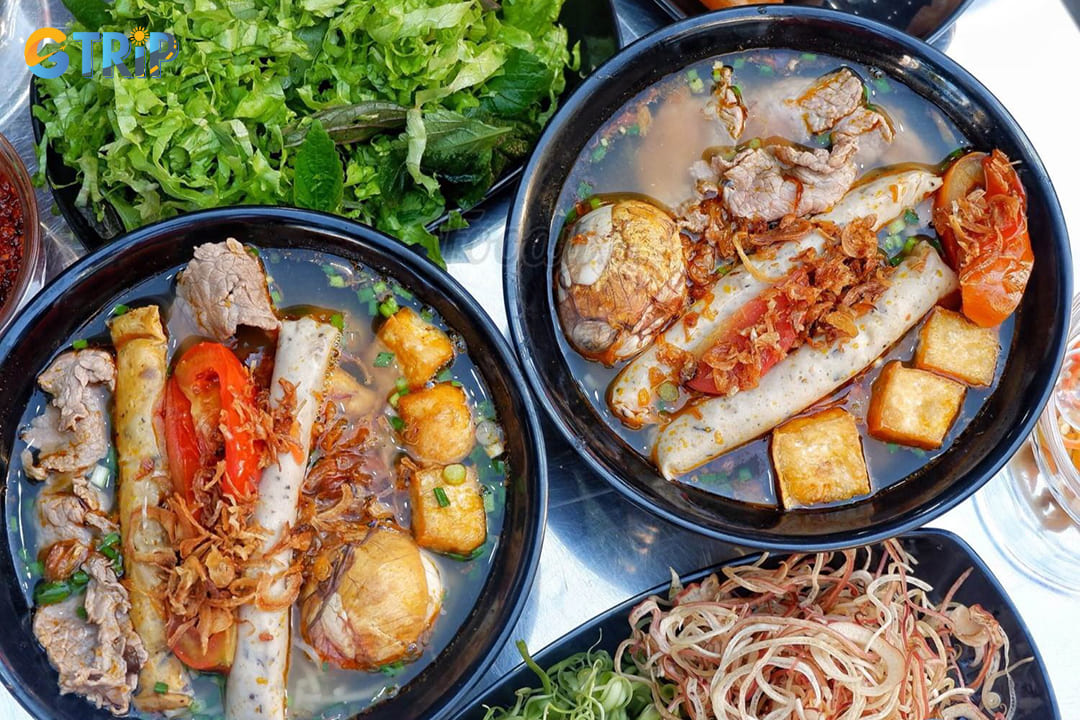
Bun rieu is a tantalizing Vietnamese crab-based noodle soup that captures the essence of Hanoi's culinary traditions
6. Bun thang
Bun thang is a sophisticated Hanoi delicacy that epitomizes the meticulous nature of northern Vietnamese cuisine. This elegant noodle soup features a clear, delicate broth made from chicken, dried shrimp, and sometimes pork bones, simmered for hours. The dish is distinguished by its artistic presentation. Thin rice vermicelli topped with up to 20 ingredients carefully arranged in colorful layers, including shredded chicken, egg ribbons, Vietnamese ham (gio), mushrooms, and herbs, creating a harmonious blend of textures and flavors.
Unlike other noodle soups with bold flavors, bun thang captivates with its subtle complexity. The name "thang" references traditional Chinese medicine, suggesting a perfectly balanced combination of ingredients. This soup originated from resourceful Hanoian households using Tet holiday leftovers to create something exquisite. The broth's depth comes from the interplay of umami notes, while the garnishes of lime, chili, and Vietnamese balm (kinh gioi) add brightness. True bun thang requires meticulous preparation - the chicken must be poached perfectly, eggs thinly sliced, and each ingredient cut to precise dimensions to maintain the dish's elegant appearance.
What makes authentic bun thang extraordinary is the final sophisticated touch, a few drops of "ca cuong" essence, an extract from a giant water bug that adds an unmistakable aroma. This rare ingredient is increasingly difficult to find, with most restaurants now using a synthetic version. For culinary enthusiasts seeking to experience Hanoi's refined cuisine heritage, bun thang offers a window into the city's culinary artistry and attention to detail.
Recommended places to try bun thang:
| Restaurant | Address | Price range |
|---|---|---|
| Bun Thang 29 Hang Hanh | 29 Hang Hanh Alley, Hoan Kiem Ward, Hanoi (29 Hang Hanh Alley, Hang Trong Ward, Hoan Kiem District, Hanoi) | About 40,000 VND/bowl (~$1.53) |
| Bun Thang 16 Lan Ong | 16 Lan Ong Street, Hoan Kiem Ward, Hanoi (16 Lan Ong Street, Hang Dao Ward, Hoan Kiem District, Hanoi) | 25,000 - 35,000 VND/bowl (~$0.96 - 1.34) |
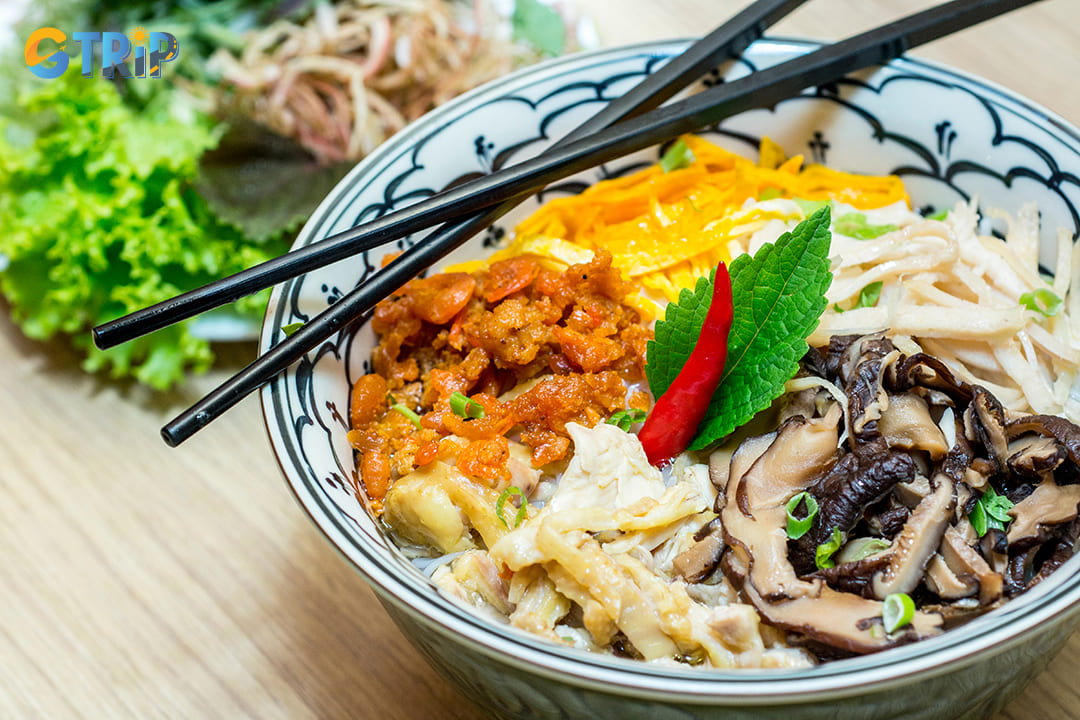
Bun thang is a sophisticated Hanoi delicacy that epitomizes the meticulous nature of northern Vietnamese cuisine
7. Banh cuon (Steamed rice rolls)
Banh cuon is a delicate rice noodle roll that exemplifies the subtlety of Hanoi cuisine. These paper-thin steamed rice sheets are filled with seasoned ground pork, wood ear mushrooms, and minced shallots, then topped with crispy fried shallots. Typically served with nuoc cham dipping sauce and fresh herbs, this breakfast favorite showcases the perfect balance between the silky texture of the rice sheets and the savory filling within. The dish requires considerable skill to prepare, as the rice batter must be spread extremely thin on a cloth stretched over boiling water.
Watching banh cuon being made is part of the experience, and many of Hanoi's best banh cuon spots have their steaming stations visible, allowing you to witness this culinary craftsmanship firsthand. Skilled artisans ladle the rice batter onto the cloth, quickly cover it, and after just seconds, use a bamboo stick to lift the translucent sheet and fold it around the filling. Traditional establishments often have the steaming stations visible to customers, allowing you to witness this culinary craftsmanship firsthand. The dish is typically garnished with Vietnamese ham (cha lua), bean sprouts, and a sprinkle of dried shrimp or shrimp floss for additional umami flavor.
What makes Hanoi's banh cuon distinctive is its lightness and the delicate nature of the rice sheets, so thin you can almost see through them, yet sturdy enough to hold the savory filling. Unlike versions found elsewhere in Vietnam, Hanoi's banh cuon tends to be more minimalist, allowing the quality ingredients and precise preparation technique to shine through rather than relying on heavy seasonings or accompaniments.
Recommended places to eat you should try:
| Restaurant | Address | Price range |
|---|---|---|
| Banh cuon Ba Xuan | No. 16 Doc Hoe Nhai, Ba Dinh Ward, Hanoi (Doc Hoe Nhai, Truc Bach, Ba Dinh, Hanoi) | 40,000 - 65,000 VND ($1.53 - 2.49) |
| Banh cuon Phuong | 68 Hang Cot, Hoan Kiem Ward, Hanoi (68 Hang Cot, Hang Ma, Hoan Kiem, Hanoi) | 30,000 - 70,000 VND ($1.15 - 2.68) |
These family-run establishments have perfected their recipes over generations, often specializing exclusively in banh cuon. The best time to enjoy this dish is early morning when the ingredients are freshest and you can observe the full preparation process. When ordering, consider requesting "banh cuon thanh tri" for the plain version or "banh cuon nhan thit" for the filled version if you want to taste both variations of this beloved Hanoi specialty.
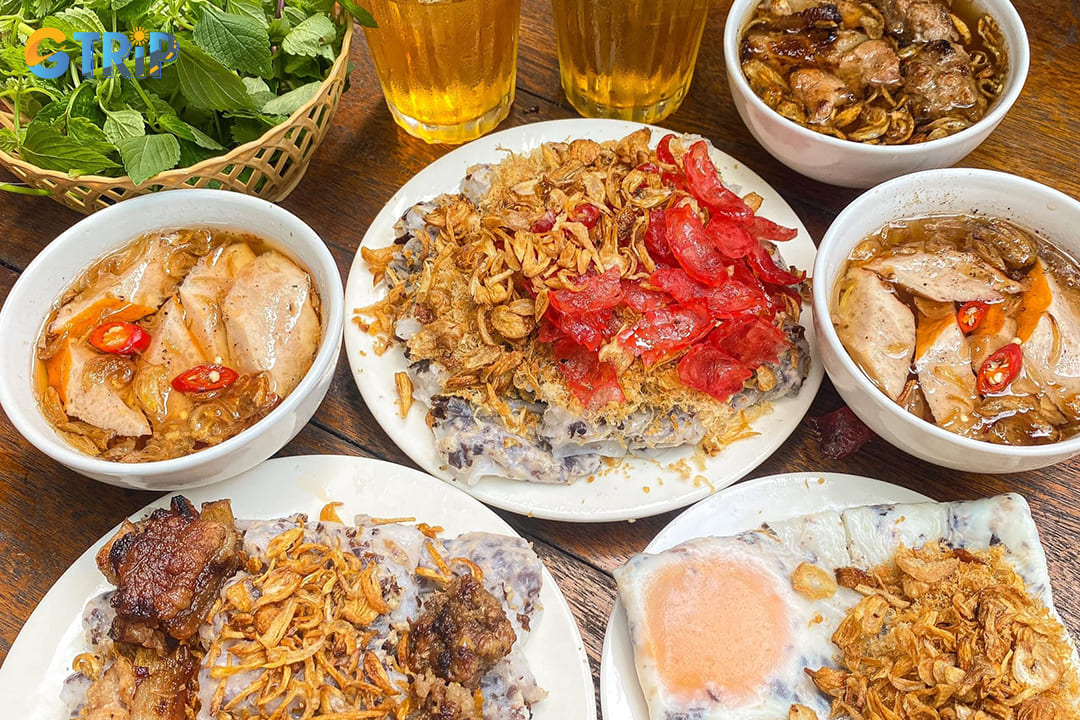
Banh cuon is a delicate rice noodle roll that exemplifies the subtlety of Hanoi cuisine
8. Chao suon (Pork rib congee)
Chao suon, or pork rib porridge, represents comfort food at its finest in Hanoi's culinary landscape. This hearty rice porridge features tender pork ribs simmered until the meat falls off the bone, creating a rich, flavorful broth. Typically served steaming hot with crispy fried dough sticks (quay), fresh herbs, and a sprinkle of pepper, chao suon offers the perfect balance of textures and flavors that Hanoians have treasured for generations.
What makes these establishments stand out is their dedication to traditional preparation methods. The porridge is cooked slowly over low heat, allowing the rice grains to break down into a silky consistency while absorbing the savory essence of the pork ribs. Many locals consider chao suon the ultimate breakfast food, providing sustained energy throughout the morning.
Recommended places to eat you should try:
| Restaurant | Location | Price range |
|---|---|---|
| Chao suon Co La | 2A Ly Quoc Su Street, Hoan Kiem Ward, Hanoi (2A Ly Quoc Su Street, Hang Trong Ward, Hoan Kiem District, Hanoi) | 15,000 - 40,000 VND ($0.57 - $1.53) |
| Chao suon Huyen Anh | Address 1: 14 Dong Xuan Street, Hoan Kiem Ward, Hanoi (14 Dong Xuan Street, Hoan Kiem District) Address 2: 4A Hang Vai Street, Hoan Kiem Ward, Hanoi (4A Hang Vai Street, Hoan Kiem District) Address 3: SH04, H2 Building - Hoa Binh Green City, Minh Khai, Vinh Tuy Ward, Hanoi (SH04, H2 Building - Hoa Binh Green City, Minh Khai, Vinh Tuy Ward, Hai Ba Trung District) | 25,000 VND/piece ($0.96) 40,000 - 60,000 VND ($1.53 - $2.30) |

Chao suon, or pork rib porridge, represents comfort food at its finest in Hanoi's culinary landscape
9. Bun oc nguoi (Snail noodle soup)
Bun oc nguoi, or cold snail noodle soup, represents a distinctive Hanoian delicacy that locals especially crave during hot summer days. This refreshing dish features rice vermicelli noodles topped with tender river snails that have been meticulously cleaned and prepared. What distinguishes this dish is its unique broth, a delicate balance of sour tamarind, aromatic herbs, and crisp vegetables. All are served at room temperature rather than hot, creating the perfect cooling street food experience for Hanoi's sweltering summers.
Bun oc nguoi offers a textural adventure that captivates both locals and curious tourists. The chewy snails provide a satisfying bite against the soft rice noodles, while the accompanying herbs add layers of fragrance. Unlike many Vietnamese soups that rely on hours of simmering, the broth here is intentionally light and tangy, allowing the natural sweetness of the snails to shine through. Vendors typically garnish the dish with fried shallots, chopped green onions, and Vietnamese coriander (rau ram), creating a harmonious blend of flavors.
What makes this dish particularly special is its seasonal nature. Many Hanoians consider it the perfect antidote to humidity, with some believing it helps cool the body during summer heat waves. The preparation process is labor-intensive, with vendors waking before dawn to clean and cook the snails, creating a broth that achieves the perfect balance between tartness and umami. The dish represents Hanoi's ingenuity in creating distinctive culinary experiences that reflect both the climate and available ingredients.
Recommended places to try bun oc nguoi:
| Restaurant | Address | Price range | Special features |
|---|---|---|---|
| Bun Oc Giang | 36 Luong Ngoc Quyen Street, Hoan Kiem Ward, Hanoi (36 Luong Ngoc Quyen Street, Hang Buom Ward, Hoan Kiem District, Hanoi) | 35,000 - 70,000 VND ($1.34 - $2.68) | Known for generous snail portions and perfectly balanced broth; popular with both locals and tourists |
| Bun Oc Ba Luong | 195 Khuong Thuong Street, Dong Da Ward, Hanoi (195 Khuong Thuong Street, Dong Da District, Hanoi) | 30,000 - 70,000 VND ($1.15 - $2.68) | Family-run for over three generations. It offers both hot and cold versions, famous for homemade chili sauce |
For adventurous eaters, bun oc nguoi provides a gateway into authentic Hanoian flavors that aren't commonly found in Vietnamese restaurants abroad. The dish perfectly exemplifies how Hanoi's food culture adapts to seasonal changes while maintaining culinary traditions that have endured for generations.
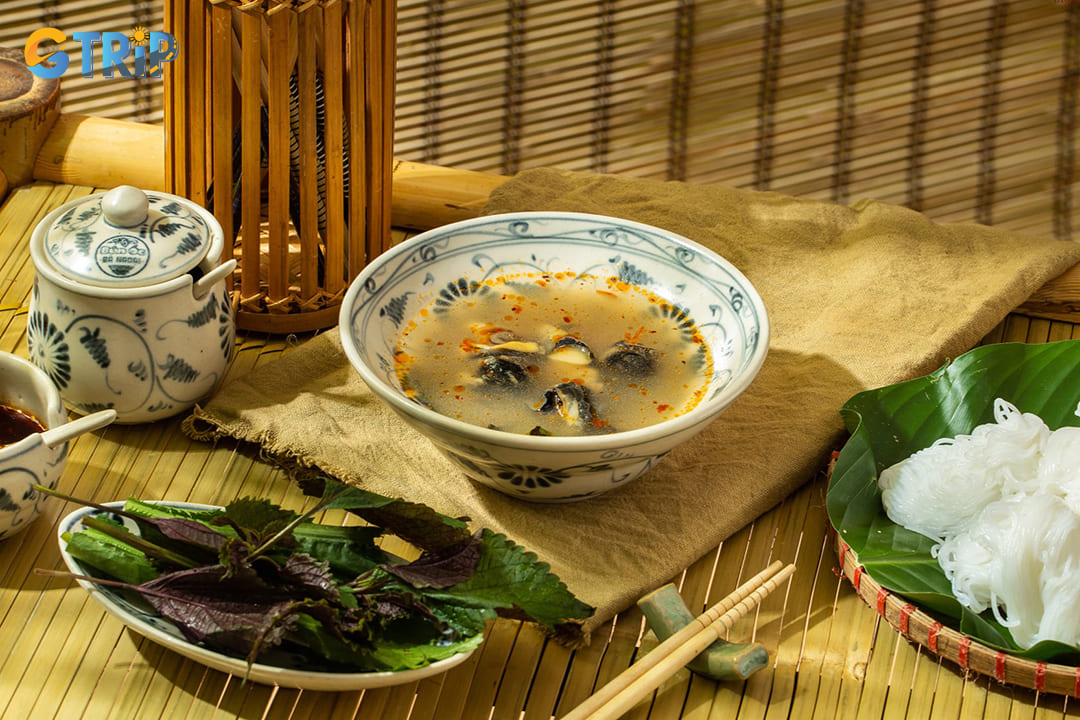
Bun oc nguoi, or cold snail noodle soup, represents a distinctive Hanoian delicacy that locals especially crave during hot summer days
10. Xoi xeo (sticky rice)
Xoi xeo stands as one of Hanoi's most beloved breakfast dishes and late-night snacks. This vibrant yellow sticky rice gets its distinctive color from turmeric and is topped with mung bean paste and crispy fried shallots. The dish is traditionally served with a sprinkle of liquid fat that gives it a glossy, appetizing sheen. What makes xoi xeo special is its perfect balance of textures, soft, glutinous rice contrasted with crunchy toppings and savory notes.
Unlike other varieties of sticky rice found across Vietnam, Hanoi's xoi xeo represents the city's preference for hearty, flavorful street food that sustains locals through their busy days. The dish is typically served in simple portions wrapped in banana leaves or lotus leaves, making it a perfect grab-and-go meal. Many Hanoians consider xoi xeo not just a meal but a cultural institution that connects generations.
Recommended places to eat you should try:
| Vendor | Address | Price range |
|---|---|---|
| Xoi xeo Oanh Oanh | 573 La Thanh, Giang Vo Ward, Hanoi (573 La Thanh, Thanh Cong, Ba Dinh, Hanoi) | 15,000 - 50,000 VND |
| Xoi suon cay 628 Truong Chinh | 628 Truong Chinh, Dong Da Ward, Hanoi (628 Truong Chinh, Nga tu so, Dong Da, Hanoi) | From 30,000 - 40,000 VND |
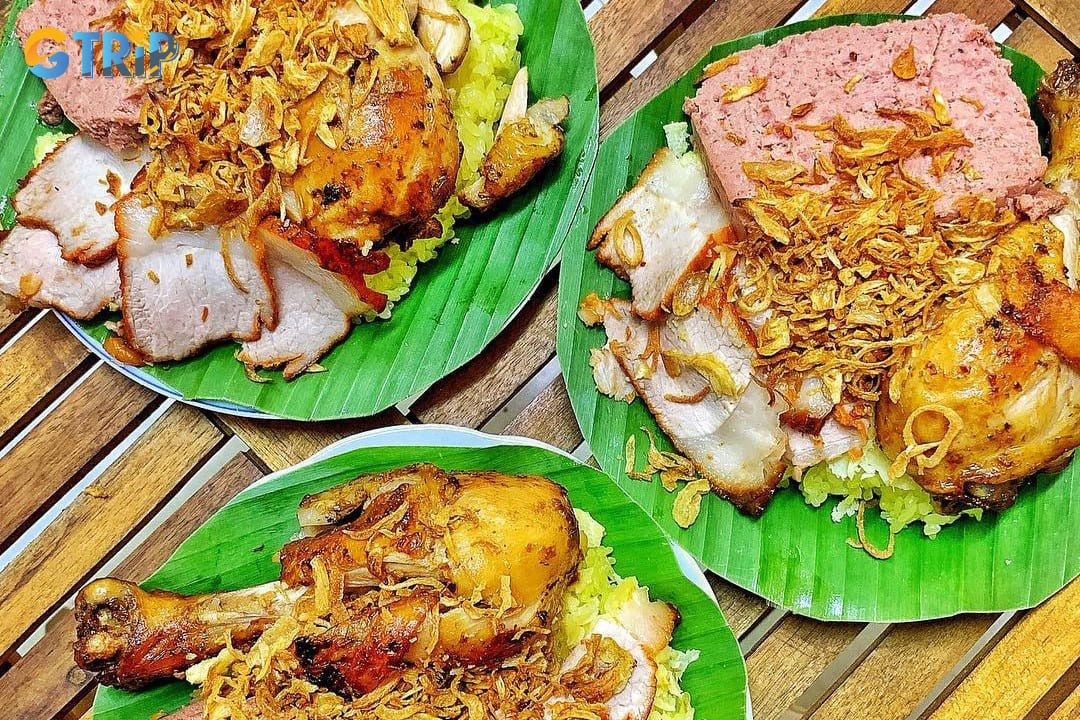
Xoi xeo stands as one of Hanoi's most beloved breakfast dishes and late-night snacks
11. Mien ngan tron
Mien ngan tron (mixed duck vermicelli) showcases the sophisticated side of Hanoi street food. It combines glass noodles with tender duck meat, crispy fried shallots, herbs, and bean sprouts. Unlike its soupy counterpart, this dry version allows the delicate flavors of duck to shine through. The dish is typically dressed with a savory-sweet fish sauce dressing and topped with crushed peanuts, creating a harmonious blend of textures and tastes that exemplifies Hanoi's culinary finesse.
The beauty of mien ngan tron lies in its perfect balance of ingredients. Fresh glass noodles provide a silky base, while the duck meat offers rich, gamey notes that pair wonderfully with the aromatic herbs. What makes this dish special is the preparation of the duck, often poached to perfection before being shredded and mixed with the other components. Many locals consider this a lighter alternative to the heavier meat dishes while still delivering satisfying flavors.
For first-time visitors, the dish might appear simple, but one bite reveals its complexity. The interplay between the slightly chewy noodles, tender duck meat, crunchy bean sprouts, and zingy dressing creates a multidimensional eating experience. Most vendors will serve it with a side of duck broth for sipping between bites, enhancing the overall enjoyment of this quintessential Hanoi specialty.
Recommended places to eat you should try:
| Restaurant | Address | Price range |
|---|---|---|
| Mien ngan Hanh | 61 To Hien Thanh Street, Hai Ba Trung Ward, Hanoi (61 To Hien Thanh Street, Le Dai Hanh Ward, Hai Ba Trung District, Hanoi) | From 40,000 VND/bowl (~$1.53) |
| Mien ngan Hanh De | A63-72 Cua Bac Street, Ba Dinh Ward, Hanoi (A63-72 Cua Bac Street, Quan Thanh Ward, Ba Dinh District, Hanoi) | About 100,000 VND |
Both establishments have built their reputations on serving authentic mien ngan tron. While Mien ngan Hanh offers a more budget-friendly option with consistently good quality. Mien ngan Hanh De provides a slightly more refined experience at a higher price point. The difference in pricing often reflects portion sizes, quality of duck meat, and restaurant ambiance.
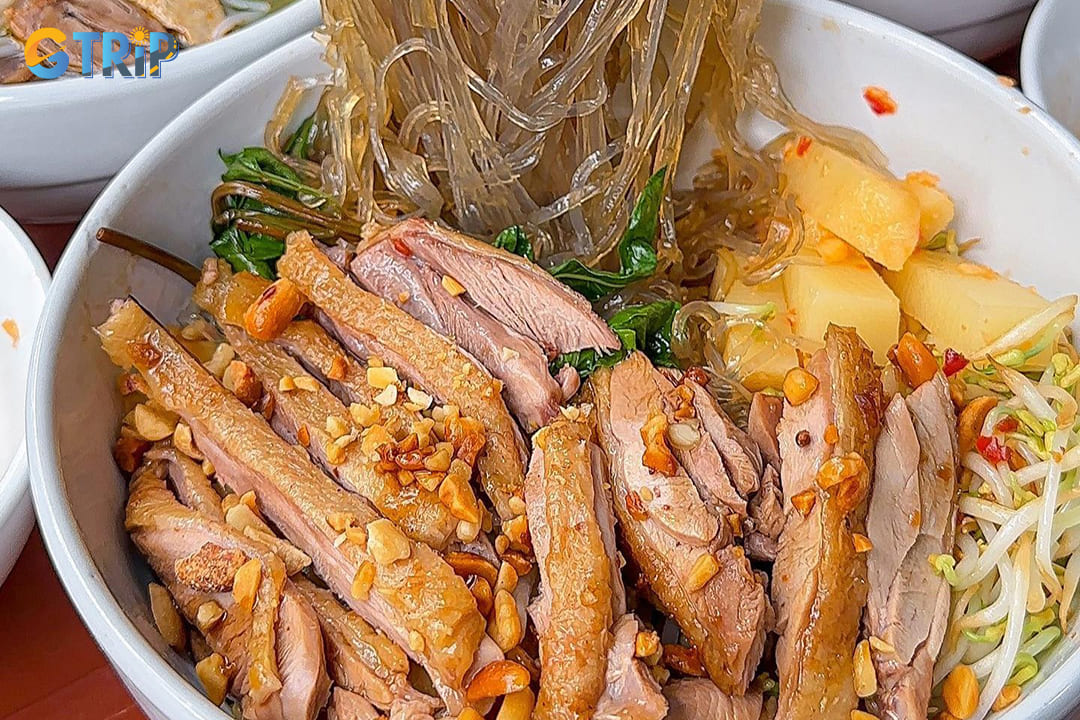
Mien ngan tron (mixed duck vermicelli) showcases the sophisticated side of Hanoi street food
12. Ngan chay toi (duck fried with garlic)
Ngan chay toi is a true Hanoi delicacy featuring tender duck meat stir-fried with abundant garlic until golden and aromatic. This dish balances the rich, slightly gamey flavor of quality duck with the pungent sweetness of caramelized garlic, creating a harmonious blend that captivates both locals and visitors. Typically served with steamed rice and fresh vegetables, it offers a complete meal that showcases the northern Vietnamese preference for simple ingredients prepared with meticulous technique.
For those unfamiliar with Vietnamese cuisine, ngan chay toi might come as a revelation. Unlike Western duck preparations that often feature crispy skin, this Hanoi specialty focuses on tender meat infused with garlic flavor. The cooking process involves marinating duck pieces with fish sauce, black pepper, and sometimes a touch of honey before stir-frying with copious amounts of minced garlic until everything reaches a beautiful caramel color. Some establishments serve the dish with a small bowl of ginger-infused fish sauce for dipping, which cuts through the richness and adds another dimension to the flavor profile.
What makes ngan chay toi special is its accessibility. It's neither an everyday dish nor an exclusive luxury, but rather a special treat that locals might enjoy for weekend family meals or casual celebrations. While less internationally famous than pho or banh mi, discovering this garlic-infused duck specialty offers travelers an authentic taste of Hanoi's diverse culinary landscape that extends beyond the usual tourist favorites.
Recommended places to eat you should try:
| Restaurant | Address | Price range |
|---|---|---|
| Ngan chay toi Thuy Luong | 61 Hang Luoc Street, Hanoi Old Quarter, Hoan Kiem Ward, Hanoi (61 Hang Luoc Street, Hanoi Old Quarter, Hoan Kiem District, Hanoi) | 100,000 - 200,000 VND ($3.83 - $7.66) |
| Ngan chay toi Tu Gu | 29A Hang Voi Street, Hoan Kiem Ward, Hanoi (29A Hang Voi Street, Ly Thai To Ward, Hoan Kiem District, Hanoi) | 10,000 - 50,000 VND ($0.38 - $1.92) |
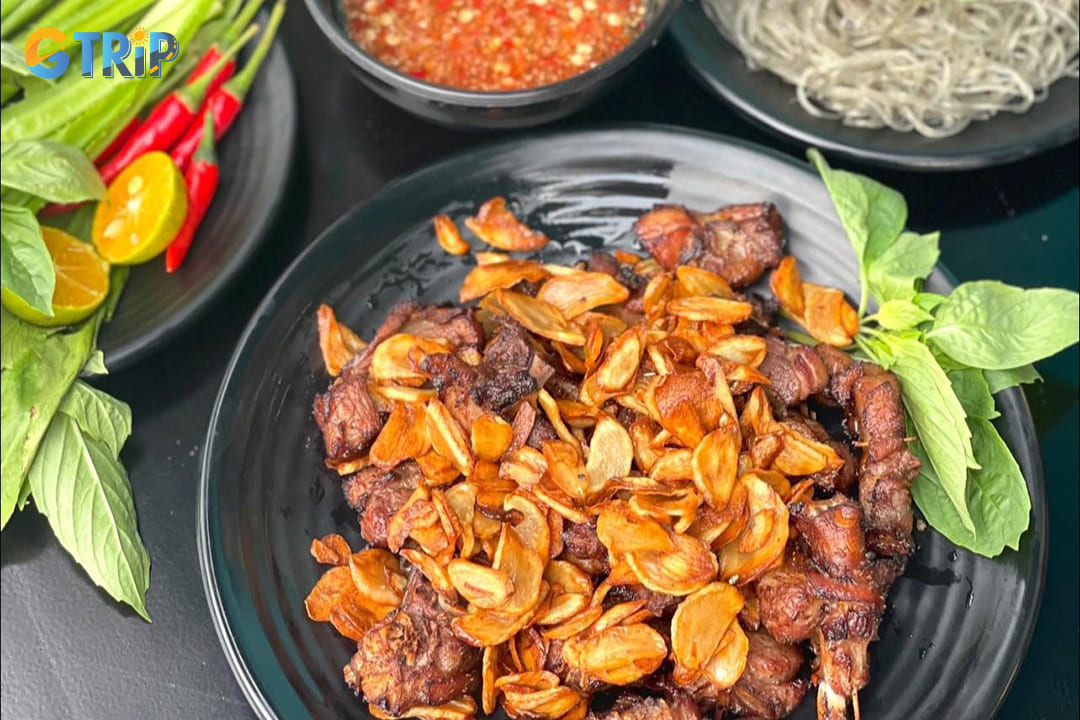
Ngan chay toi is a true Hanoi delicacy featuring tender duck meat stir-fried with abundant garlic until golden and aromatic
13. Banh gio
Banh gio is a beloved Hanoi street food featuring a pyramid-shaped rice flour dumpling with savory pork filling, wrapped in banana leaves. This steamed delicacy has a distinctive soft, slightly glutinous texture with a rich aroma from the banana leaf wrapping. The fluffy exterior conceals a hearty filling of minced pork, wood ear mushrooms, and sometimes quail eggs. Traditionally eaten for breakfast or as an afternoon snack, banh gio is typically served with chili sauce and pickled vegetables that perfectly complement its delicate flavor.
What makes banh gio special is its preparation process, which requires skilled hands to properly shape and wrap the dough. The banana leaf imparts a subtle fragrance and creates the iconic pyramid shape that distinguishes it from other Vietnamese dumplings. While simple in appearance, achieving the perfect consistency, firm enough to hold its shape yet delightfully tender when bitten into, requires expertise that has been passed down through generations of Hanoi's culinary artisans.
Recommended places to eat you should try:
| Restaurant | Address | Price range |
|---|---|---|
| Banh gio Dong Cac | 33 Dong Cac Street, Dong Da Ward, Hanoi (33 Dong Cac Street, Cho Dua Ward, Dong Da District, Hanoi) | 20,000 - 33,000 VND ($0.77 - 1.26) |
| Banh gio Co Beo | 3 Thuy Khue Street, Ba Dinh Ward, Hanoi (3 Thuy Khue Street, Ba Dinh District, Hanoi) | 25,000 - 45,000 VND ($0.96 - 1.72) |
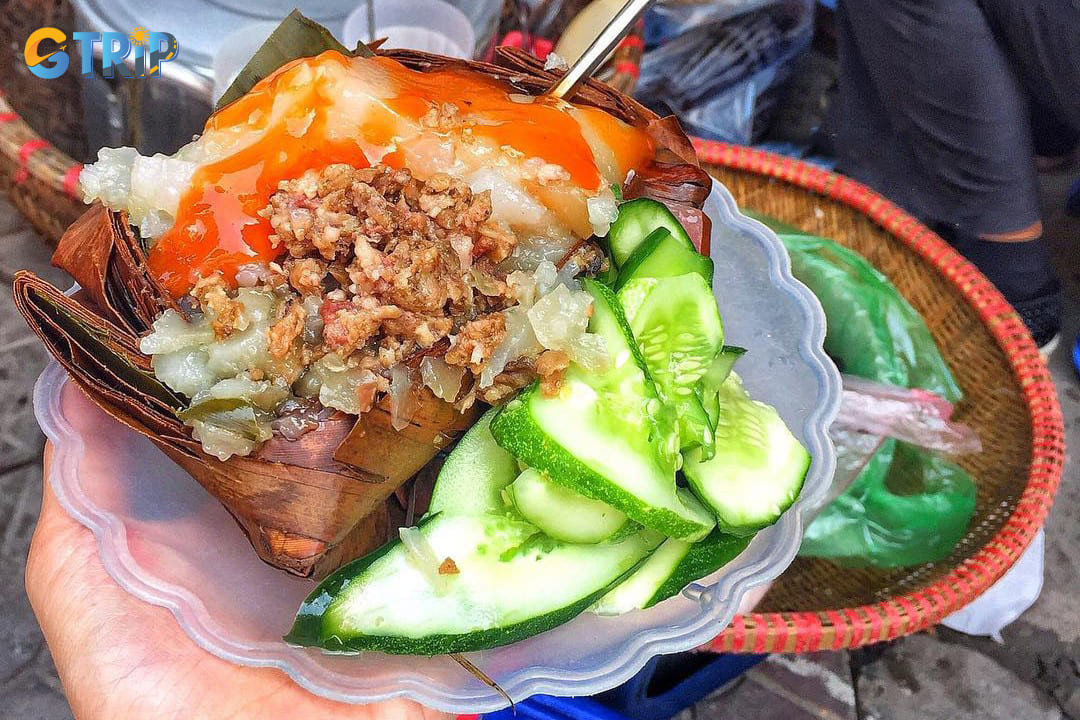
Banh gio is a beloved Hanoi street food featuring a pyramid-shaped rice flour dumpling with savory pork filling, wrapped in banana leaves
14. Cha ruoi (Sandworm omelette)
Cha ruoi is one of Hanoi's most distinctive seasonal delicacies, available only from late autumn to early winter (September to November). This unique dish features sandworms harvested from Northern Vietnam's coastal areas, mixed with eggs, tangerine peel, dill, and spices before being fried into savory, crispy-edged patties. For adventurous food lovers, this unusual delicacy offers a remarkable blend of seafood flavors with aromatic herbs that capture the essence of Hanoi's seasonal cuisine traditions.
The preparation of cha ruoi involves careful cleaning of the worms before mixing them with aromatics. Local culinary experts recommend enjoying this dish with fresh herbs, rice vermicelli, and a spicy fish sauce dip to balance the richness. The texture is uniquely crunchy yet tender, with a distinctive umami flavor that might initially surprise Western palates but quickly becomes addictive.
Recommended places to try cha ruoi:
| Restaurant | Address | Price range |
|---|---|---|
| Cha Ruoi Hang Beo | 244 Lo Duc Street, Hai Ba Trung Ward, Hanoi (244 Lo Duc Street, Dong Nhan Ward, Hai Ba Trung District, Hanoi) | 30,000 - 100,000 VND ($1.15 - 3.83) |
| Cha Ruoi Lien Yen (at Bia Hoi Lien Yen) | No. 5, O Quan Chuong Street, Hoan Kiem Ward, Hanoi (No. 5, O Quan Chuong Street, Hang Buom Ward, Hoan Kiem District, Hanoi) | From 25,000 VND/bowl (~$0.96) |

Cha ruoi is one of Hanoi's most distinctive seasonal delicacies, available only from late autumn to early winter (September to November)
For the authentic experience, visit during October when the dish is at its seasonal peak. Locals believe the best sandworms come from northern coastal provinces like Hai Phong and Quang Ninh, with restaurants proudly advertising their worm sourcing. While controversial to some visitors, cha ruoi represents Hanoi's embrace of seasonal ingredients and the Vietnamese philosophy.
15. Cha ca La Vong
Cha ca La Vong is one of Hanoi's most iconic and historical dishes, dating back over 130 years. This sizzling turmeric-marinated fish, traditionally made with hemibagrus (a type of catfish), is seasoned with dill, spring onions, and various herbs, then fried tableside in a hot pan with oil. The dish is served with rice noodles, roasted peanuts, fresh herbs, and a fermented shrimp sauce called mam tom, creating a perfect balance of flavors and textures that represents the sophisticated culinary heritage of Hanoi.
When eating cha ca, locals recommend mixing all components together in your bowl: the fish, herbs, noodles, and a small amount of the pungent mam tom sauce. First-time visitors might find the fermented shrimp sauce strong, but it's an essential part of the authentic experience. For a milder flavor, start with just a little sauce and adjust to your taste.
Recommended places to eat:
| Restaurant | Address | Price range |
|---|---|---|
| Cha ca La Vong 14 Pho Cha Ca | 14 Cha Ca Street, Hoan Kiem Ward, Hanoi (14 Cha Ca Street, Hang Bo Ward, Hoan Kiem District, Hanoi) | 150,000 - 170,000 VND ($5.75 - 6.51) |
| Cha ca La Vong Thang Long | 2D and 6B Duong Thanh Street, Hoan Kiem Ward, Hanoi (2D and 6B Duong Thanh Street, Hoan Kiem District, Hanoi) | 7,000 VND/piece ($0.27/piece) |
The dish's popularity extends beyond Vietnam, with food critics and chefs worldwide recognizing it as one of Southeast Asia's most distinctive culinary creations. Anthony Bourdain famously featured this dish during his visit to Hanoi, helping introduce it to international audiences and securing its place among Vietnam's must-try foods.
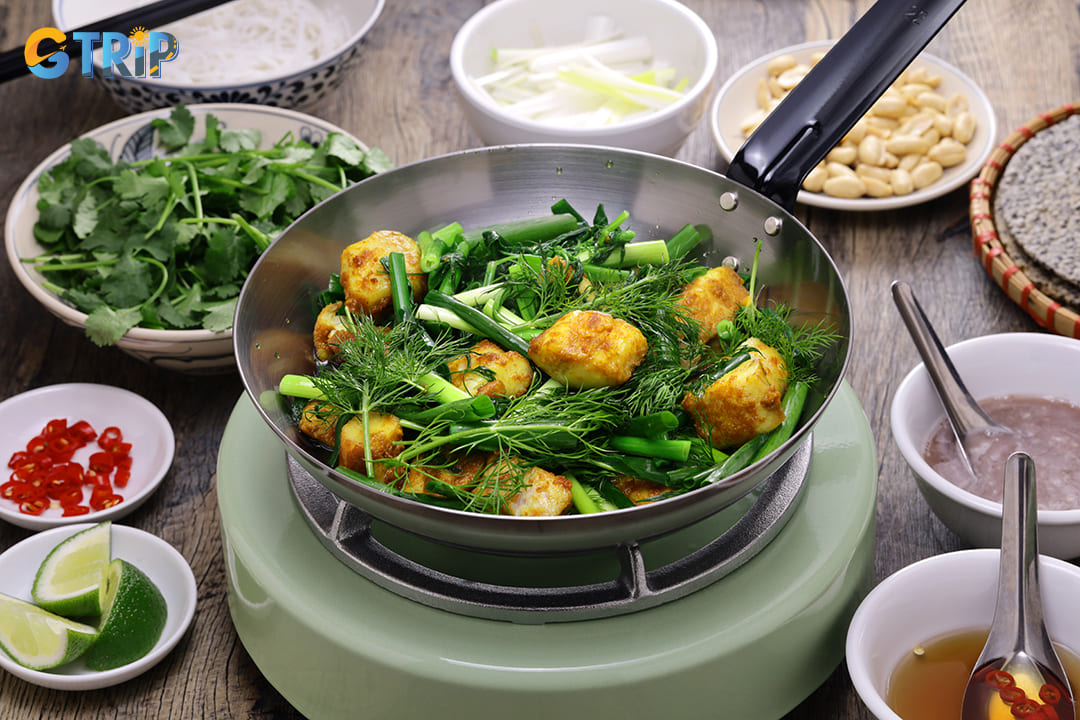
Cha ca La Vong is one of Hanoi's most iconic and historical dishes, dating back over 130 years
16. Nem chua ran
Nem chua ran (fried fermented pork rolls) represents one of Hanoi's most beloved street snacks, combining the tangy flavor of fermented pork with a crispy, golden exterior. This bite-sized delight features fermented pork wrapped in rice paper, coated in a light batter, then deep-fried until perfectly crisp. The contrast between the sour filling and the crunchy coating creates an irresistible texture that keeps both locals and visitors coming back for more. Typically served hot with herbs and a sweet chili dipping sauce, nem chua ran offers an affordable yet addictive taste of Hanoi's street food culture.
The popularity of nem chua ran stems from its perfect balance of flavors and textures. The fermentation process gives the pork a distinct tangy taste that pairs wonderfully with the crispy exterior. Street vendors throughout Hanoi have perfected this simple snack, with many locations developing their own special recipes and dipping sauces that set them apart from competitors. For first-time visitors to Hanoi, sampling nem chua ran provides an authentic taste of local culinary traditions at a remarkably affordable price.
Recommended places to eat you should try:
| Vendor | Address | Price range |
|---|---|---|
| Nem chua ran Thuy Khue | 30 Alley 21, Lane 29 Thuy Khue Street, Tay Ho Ward, Hanoi (30 Alley 21, Lane 29 Thuy Khue Street, Tay Ho District, Hanoi) | 6,000 VND/piece |
| Nem chua ran 36 Tam Thuong | 36 Tam Thuong Alley, Hoan Kiem Ward, Hanoi (36 Tam Thuong Alley, Hang Gai Ward, Hoan Kiem District, Hanoi) | 50,000 - 100,000 VND |
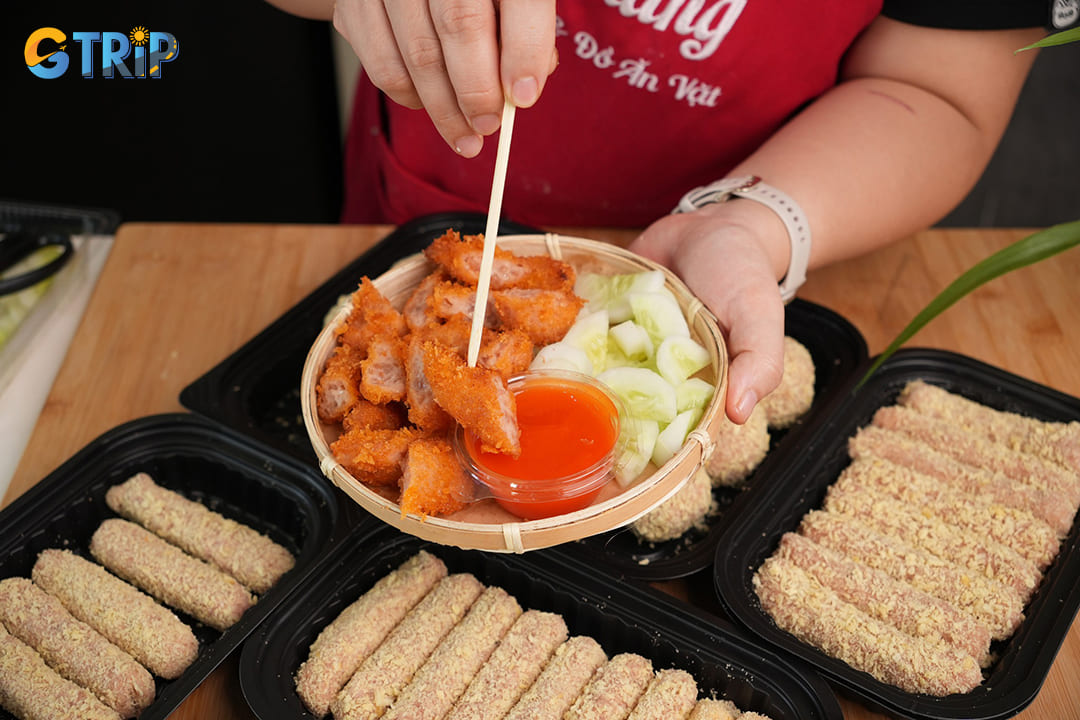
Nem chua ran (fried fermented pork rolls) represents one of Hanoi's most beloved street snacks, combining the tangy flavor of fermented pork with a crispy, golden exterior
17. Com (Young green rice)
Com refers to Vietnam's beloved young green rice, harvested when rice grains are still tender and aromatic. Hanoi's artisans transform these precious young grains into delicate flakes (com), sweet green rice cakes (banh com), and fragrant steamed sticky rice (xoi com). This seasonal delicacy, traditionally enjoyed in autumn, embodies the agricultural heritage of Vietnam with its distinctly grassy aroma and subtly sweet flavor. A true taste of Hanoi's countryside brought to the city, com represents the delicate balance between tradition and simplicity in Vietnamese cuisine.
The most famous com originates from Me Tri and Vong villages, where families have preserved traditional production methods for generations. The labor-intensive process involves carefully selecting young rice paddies, hand-harvesting the grains, roasting them over low heat, and repeatedly pounding and sifting until the perfect texture is achieved. The distinctive emerald green color and aromatic profile come from this meticulous process, unchanged for centuries.
Com can be enjoyed in various ways: eaten plain to savor its natural sweetness, paired with ripe bananas for a simple snack, or incorporated into more elaborate desserts. While traditionally a seasonal autumn treat coinciding with rice harvests, Hanoi's food artisans now make these specialties available year-round for visitors to experience.
Recommended places to eat you should try:
| Restaurant | Address | Price range |
|---|---|---|
| Banh Com Lang Vong Ba Hoan (Green Rice Cake) | No. 36, Alley 63, Xuan Thuy Street, Cau Giay Ward, Hanoi (No. 36, Alley 63, Xuan Thuy Street, Dich Vong Hau Ward, Cau Giay Ward, Hanoi) | 6,000 - 8,000 VND ($0.23 - 0.31) |
| Banh Com Nguyen Ninh Hang Than | No. 1 & 73 Hang Than Street, Ba Dinh Ward, Hanoi (No. 1 & 73 Hang Than Street, Truc Bach Ward, Ba Dinh District, Hanoi) | 40,000 - 770,000 VND ($1.53 - 29.50) |
| Xoi Com Me Tri | Com village, Tu Liem Ward, Hanoi (Com village, Me Tri Thuong Ward, Tu Liem District, Hanoi) | About 200,000 VND/kg ($7.66) |
When visiting these establishments, consider trying these popular com-based specialties:
- Com wrapped in lotus leaf: Fresh com wrapped in lotus leaves, which impart a subtle floral fragrance
- Banh com: Sweet cakes with mung bean filling, wrapped in banana leaves and often given as gifts
- Che com: Sweet soup made with young rice, coconut milk, and lotus seeds
- Cha com: Grilled pork patties mixed with young sticky rice for added aroma and texture
For the most authentic experience, visit Hanoi during the autumn months (August to October). This is when fresh com is at its peak quality and local festivals celebrate this traditional delicacy.
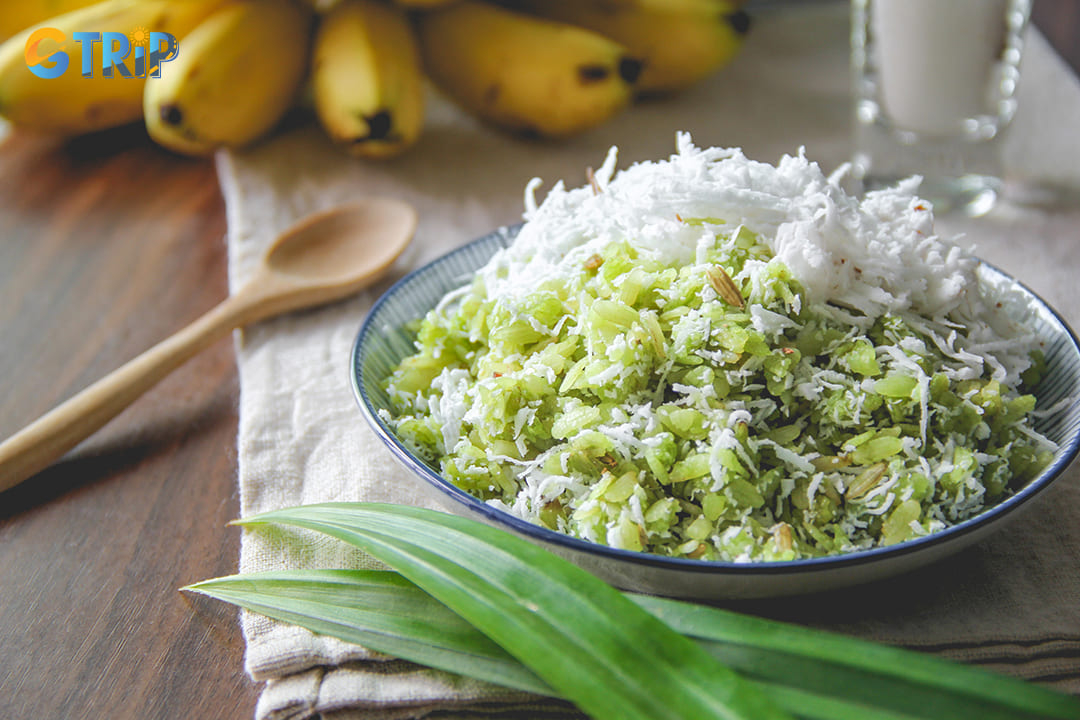
Com refers to Vietnam's beloved young green rice, harvested when rice grains are still tender and aromatic
Read more: Top 20 Must-Have Souvenirs and Gifts to Buy in Hanoi
18. Mi ga tan (Herbal stewed chicken noodles)
Mi ga tan stands out among Hanoi's culinary treasures as a nourishing medicinal dish that combines tender chicken with aromatic Chinese herbs. This therapeutic noodle soup features thin rice noodles swimming in a rich, amber-colored broth that's been simmered for hours with traditional herbs like goji berries, jujube dates, and ginseng. Often served during colder months or to those recovering from illness, mi ga tan offers both comfort and healing benefits. It also delivers a complex, earthy flavor profile unique to traditional Vietnamese-Chinese cuisine.
Health benefits of mi ga tan:
- Goji berries provide antioxidants and immune system support
- The slow-simmered chicken broth delivers easily digestible proteins
- Traditional Chinese herbs like astragalus and angelica root have anti-inflammatory properties
- The combination of ingredients creates a balanced dish according to traditional Asian medicine
- Many locals consider it an ideal recovery food after illness or during seasonal transitions
Recommended places to eat you should try:
| Restaurant | Address | Price range |
|---|---|---|
| Mi ga tan Cay Si | 29 Tong Duy Tan Street, Hoan Kiem Ward, Hanoi (29 Tong Duy Tan Street, Hang Bong Ward, Hoan Kiem District, Hanoi) | About 60,000 VND ($2.30) |
| Mi ga tan Mai Huong | 12C Hang Cot Street, Old Quarter, Hoan Kiem Ward, Hanoi (12C Hang Cot Street, Old Quarter, Hoan Kiem District, Hanoi) | 10,000 - 15,000 VND ($0.38 - 0.57) |
The dish is particularly popular during Hanoi's winter months when locals seek warming foods that strengthen the body against the damp cold of northern Vietnam.
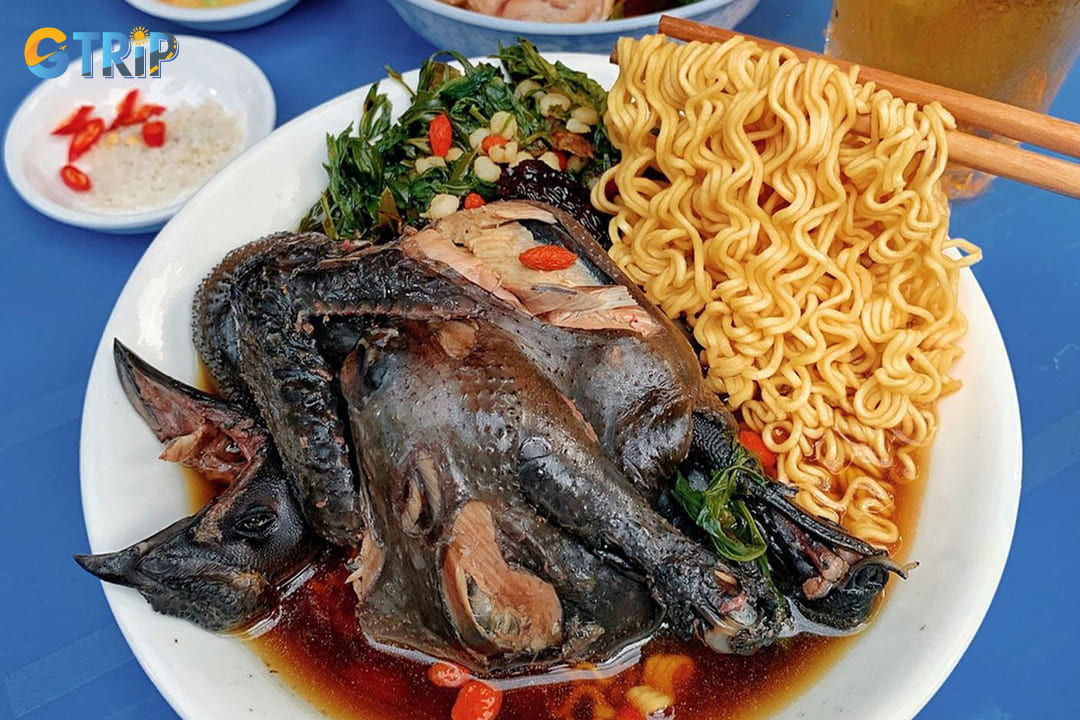
Mi ga tan stands out among Hanoi's culinary treasures as a nourishing medicinal dish that combines tender chicken with aromatic Chinese herbs
Read more: Top 10+ Best and Most Popular Chinese Restaurants in Hanoi
19. Bun doc mung
Bun doc mung is a lesser-known but cherished Hanoi delicacy featuring rice noodles in a unique broth made from doc mung (arrowhead plant). This dish combines the subtle earthy flavor of arrowhead stems with the richness of pork or chicken, creating a light yet satisfying meal. The broth is typically clear with a distinctive aroma, garnished with fresh herbs and crispy fried shallots. Locals especially seek this dish during summer months when its refreshing qualities provide relief from Hanoi's humidity.
What makes bun doc mung special is its perfect balance of flavors, neither too overpowering nor too bland. The arrowhead plant gives the broth a slightly viscous texture that coats the rice noodles beautifully. Traditional preparation involves simmering the doc mung stems with pork bones for hours to extract maximum flavor. The result is a bowl of noodles that showcases Hanoi's ability to transform simple ingredients into extraordinary dishes.
For the authentic experience, Hanoi locals recommend eating bun doc mung for breakfast or lunch. The dish represents Hanoi's heritage cuisine that has maintained its authentic preparation methods through generations. While not as internationally famous as pho or bun cha, bun doc mung holds a special place in Hanoian culinary traditions, especially among those seeking out traditional tastes beyond the tourist favorites.
Recommended places to eat you should try:
| Restaurant | Address | Price range |
|---|---|---|
| Bun doc mung Co Cham | 39/4 Hai Ba Trung Street, Cua Nam Ward, Hanoi (39/4 Hai Ba Trung Street, Tran Hung Dao Ward, Hoan Kiem District, Hanoi) | About 35,000 VND ($1.34) |
| Bun doc mung Ba Hieu | 10A Dien Bien Phu Street, Ba Dinh Ward, Hanoi (10A Dien Bien Phu Street, Dien Bien Ward, Ba Dinh District, Hanoi) | 20,000 - 50,000 VND ($0.77 - $1.92) |
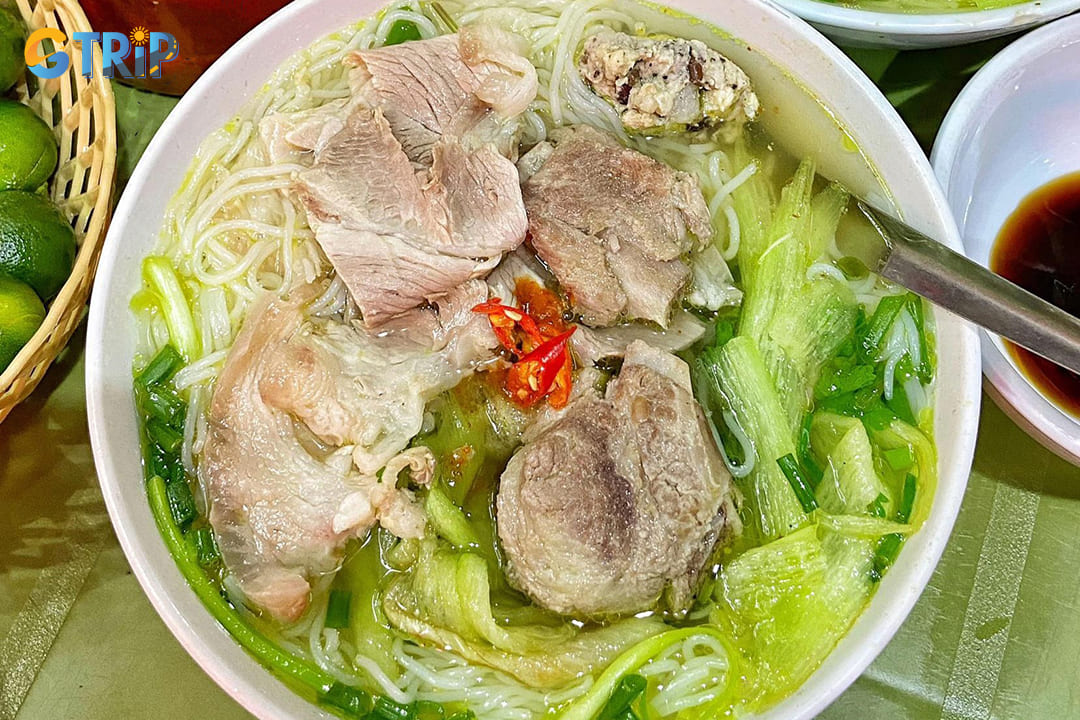
Bun doc mung is a lesser-known but cherished Hanoi delicacy featuring rice noodles in a unique broth made from doc mung (arrowhead plant)
20. Sua do (Red Jellyfish)
Sua do, or red jellyfish, is one of Hanoi's most unique seasonal delicacies, available only from March to May when jellyfish migrate to the Gulf of Tonkin. This distinctive dish features small, translucent jellyfish with a reddish tint and a crunchy texture that creates a fascinating contrast with the sweet, sour, and slightly spicy sauce. Unlike most jellyfish dishes around the world, Hanoi's sua do is served in a refreshing dessert-like preparation that offers the perfect cooling relief during the early summer heat.
The jellyfish is carefully prepared by removing any stinging parts, then washed thoroughly in salted water before being mixed with a combination of ingredients, including kumquat juice, sugar, chili, and sometimes crushed peanuts. The resulting dish provides a complex sensory experience, simultaneously crunchy, refreshing, sweet, and tangy with a subtle oceanic flavor that makes it truly unforgettable.
Recommended places to try sua do:
| Restaurant | Address | Price range |
|---|---|---|
| Sua do Cu Gai | 70 Hang Chieu Street, Hoan Kiem Ward, Hanoi (70 Hang Chieu Street, Hang Buom Ward, Hoan Kiem District, Hanoi) | 30,000 - 50,000 VND ($1.15 - 1.92) |
| Sua do Duong Thanh | 16B Duong Thanh Street, Hoan Kiem Ward, Hanoi (16B Duong Thanh Street, Hoan Kiem District, Hanoi) | 100,000 - 200,000 VND ($3.83 - 7.66) |
Most locals recommend trying sua do in the late afternoon as a refreshing snack rather than as part of a main meal. The dish's popularity peaks in April when the jellyfish are said to have the perfect texture and flavor. Because of its limited seasonal availability and unique taste profile, experiencing sua do has become something of a springtime ritual for Hanoians and a true culinary adventure for visitors lucky enough.
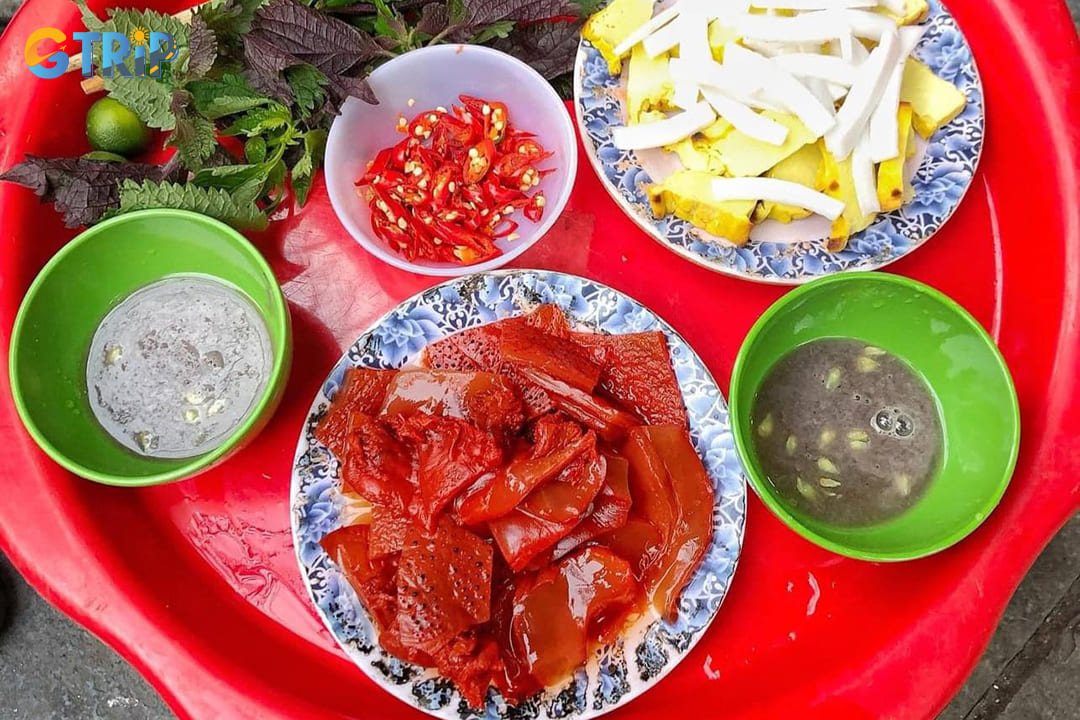
Sua do, or red jellyfish, is one of Hanoi's most unique seasonal delicacies, available only from March to May when jellyfish migrate to the Gulf of Tonkin
Read more: Guide to Hanoi in April to make the most of your trip
21. Mien luon
Mien luon is a uniquely Hanoian delicacy featuring glass noodles topped with crispy fried eel, fresh herbs, bean sprouts, and a savory broth. The tender yet chewy glass noodles perfectly complement the distinct texture of the eel, which is often served both crispy-fried and soft-simmered. What makes this dish special is the aromatic blend of Vietnamese coriander, mint, and crispy fried shallots, all enhanced by a drizzle of lime juice and chili for a perfectly balanced flavor profile.
This humble yet sophisticated dish represents Hanoi's culinary ingenuity, transforming the common eel into a beloved street food staple. Traditionally enjoyed as a breakfast or lunch option, mien luon offers a lighter alternative to more filling noodle soups while still delivering complex flavors. The dish comes in two popular variations: mien luon kho (dry) with minimal broth, and mien luon nuoc (soup version) featuring a rich, slow-simmered eel broth.
Recommended places to eat you should try:
| Restaurant | Location | Price range |
|---|---|---|
| Mien Luon Chan Cam | 1 Chan Cam Street, Hoan Kiem Ward, Hanoi (1 Chan Cam Street, Hang Trong Ward, Hoan Kiem District, Hanoi)i | 20,000 - 50,000 VND ($0.77 - 1.92) |
| Mien Luon Dong 42 Thai Ha | 42 Thai Ha Street, Dong Da Ward, Hanoi (42 Thai Ha Street, Trung Liet Ward, Dong Da District, Hanoi) | 35,000 VND ($1.34) |
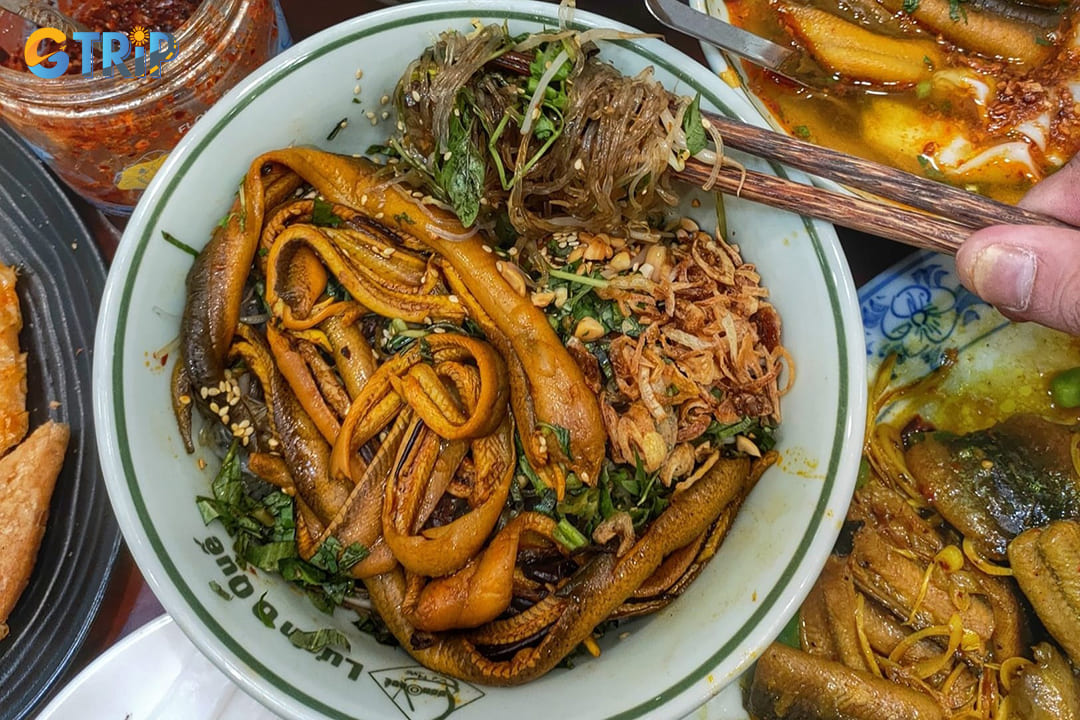
Mien luon is a uniquely Hanoian delicacy featuring glass noodles topped with crispy fried eel, fresh herbs, bean sprouts, and a savory broth
22. Banh tom Tay Ho
Banh tom Tay Ho (West Lake shrimp cakes) is a crispy delicacy that originated from the shores of Hanoi's largest freshwater lake. These golden-fried cakes feature a perfect combination of sweet potato and fresh shrimp, creating a delightful contrast of textures, crispy exterior giving way to a tender interior. Traditionally served with a fish sauce-based dipping sauce and a side of herbs including lettuce, mint, and coriander, these shrimp cakes represent one of Hanoi's most beloved lakeside treats.
What makes Banh tom Tay Ho special is its connection to the place. The dish is named after West Lake (Ho Tay), where it was first created using shrimp caught directly from these waters. Today, it remains a must-try delicacy that captures the essence of Hanoi's lakeside culinary traditions. The ideal way to enjoy this dish is to wrap the hot, crispy cake in herbs and lettuce before dipping it into the sweet and tangy nuoc cham sauce.
Recommended places to eat you should try:
| Restaurant | Address | Price range |
|---|---|---|
| Banh Tom Tay Ho Thanh Tam | 43 Phu Tay Ho, Quang An Ward, Tay Ho Ward, Hanoi (43 Phu Tay Ho, Quang An Ward, Tay Ho District, Hanoi) | About 150,000 VND/10 pieces ($5.75/10 pieces) |
| Banh Tom Tay Ho Hoa Nha | 49 Alley 50, Dang Thai Mai Street, Hong Ha Ward, Hanoi (49 Alley 50, Dang Thai Mai Street, Quang An Ward, Tay Ho District, Hanoi) | 50,000 - 100,000 VND ($1.92 - $3.83) |
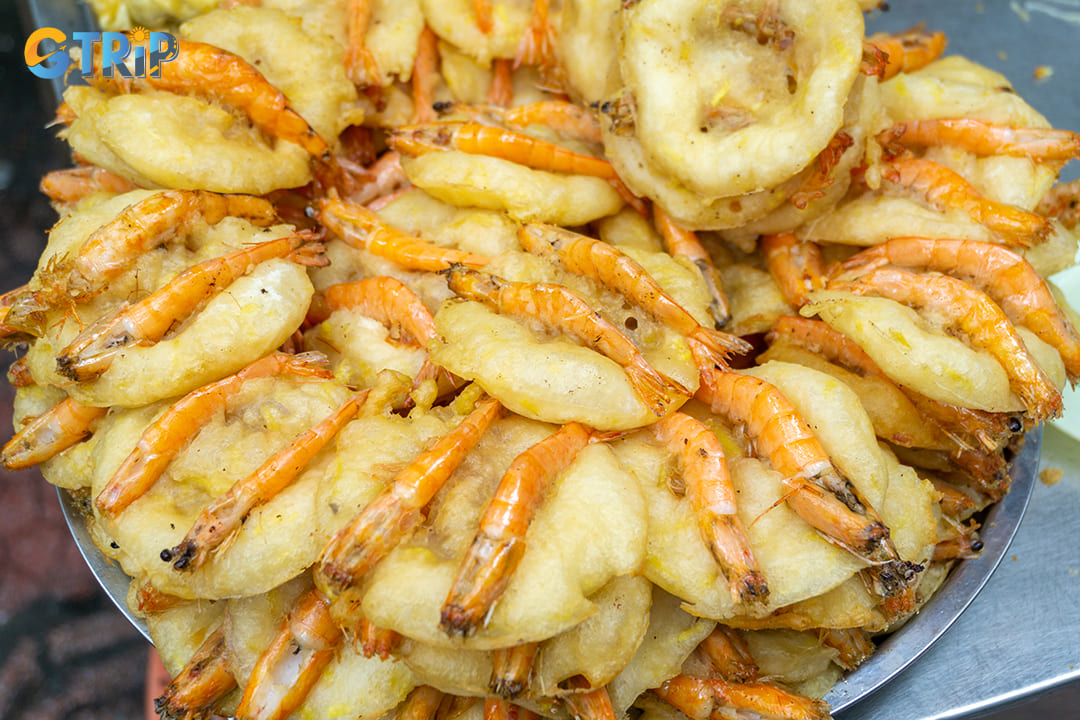
Banh tom Tay Ho (West Lake shrimp cakes) is a crispy delicacy that originated from the shores of Hanoi's largest freshwater lake
23. Long ran (fried pork intestines)
Long ran, or fried pork intestines, represents the bold, adventurous side of Hanoi's street food culture. This crispy, golden-brown delicacy consists of thoroughly cleaned pork intestines, marinated in a blend of lemongrass, garlic, and traditional Vietnamese spices before being deep-fried to perfection. The result is a crunchy exterior with a chewy, flavorful interior that delivers a unique combination of textures and tastes that embodies Hanoi's nose-to-tail culinary philosophy.
The dish is typically served with a tangy dipping sauce made from fish sauce, lime juice, garlic, and chili, creating a perfect balance between the richness of the intestines and the brightness of the sauce. What makes long ran special is the careful preparation process. The intestines must be meticulously cleaned and marinated to remove any unpleasant odors while absorbing the aromatic spices.
For travelers seeking authentic Vietnamese street food experiences, long ran offers a glimpse into the resourceful cooking traditions that have been passed down through generations in Hanoi. While it might seem intimidating to first-timers, those who dare to try are often surprised by its addictive qualities.
Recommended places to eat that you should try
| Restaurant | Address | Price range |
|---|---|---|
| Long ran 23 Nguyen Sieu | 23 Nguyen Sieu Street, Hoan Kiem Ward, Hanoi (23 Nguyen Sieu Street, Hang Buom Ward, Hoan Kiem District, Hanoi) | 100,000 - 200,000 VND ($3.83 - 7.66) |
| Long ran 37 Phung Hung | 37 Phung Hung Street, Hoan Kiem Ward, Hanoi (37 Phung Hung Street, Hang Ma Ward, Hoan Kiem District, Hanoi) | About 40,000 VND (About $1.53) |
Tips for first-timers:
- Start with a small portion if you're new to offal dishes
- Pair with local rice wine (ruou) or a cold beer for an authentic experience, similar to the vibe at Bia hoi corner
- Visit during evening hours when the intestines are freshly fried
- The Phung Hung location offers better value but more basic seating
- Try the mixed platter that includes other offal varieties for a complete experience
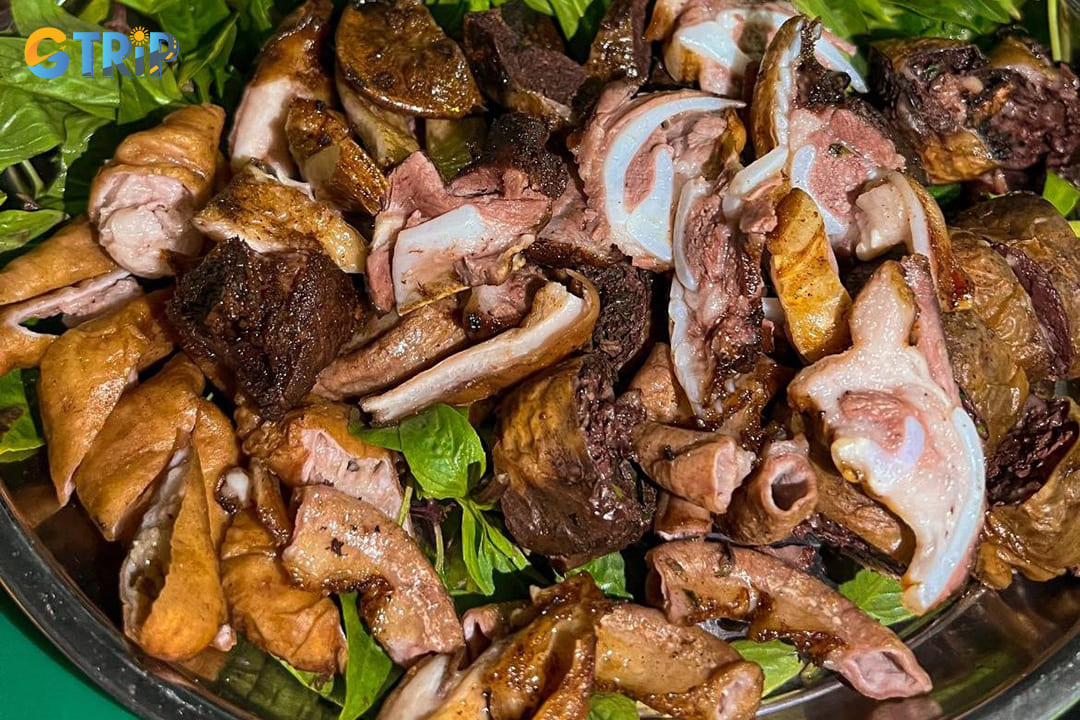
Long ran, or fried pork intestines, represents the bold, adventurous side of Hanoi's street food culture
24. Nom bo kho (Dried beef salad)
Nom bo kho is a signature Hanoi street food that perfectly balances sweet, sour, spicy, and savory flavors. Made with thinly shredded green papaya or mango, the salad is topped with chewy strips of seasoned dried beef, fresh herbs, roasted peanuts, and a hint of chili for extra heat. Tossed in a tangy fish sauce dressing, it delivers a refreshing yet satisfying taste that locals especially enjoy during Hanoi’s hot summer days. With its mix of crunchy, chewy, and aromatic elements, nom bo kho has become both a beloved street snack and a favorite dish at family gatherings.
Where to try:
| Restaurant | Address | Price range |
|---|---|---|
| Nom Bo Kho Van (Green Papaya Salad with Dried Beef) | 16B Duong Thanh Street, Hoan Kiem Ward (16B Duong Thanh Street, Cua Dong Ward, Hoan Kiem District, Hanoi) | 20,000 - 40,000 VND ($0.77 - 1.53) |
| Nom Bo Kho Mai Nga | 25 Ham Long Street, Hoan Kiem Ward (25 Ham Long Street, Hoan Kiem District, Hanoi) | From 5,000 VND ($0.19) |
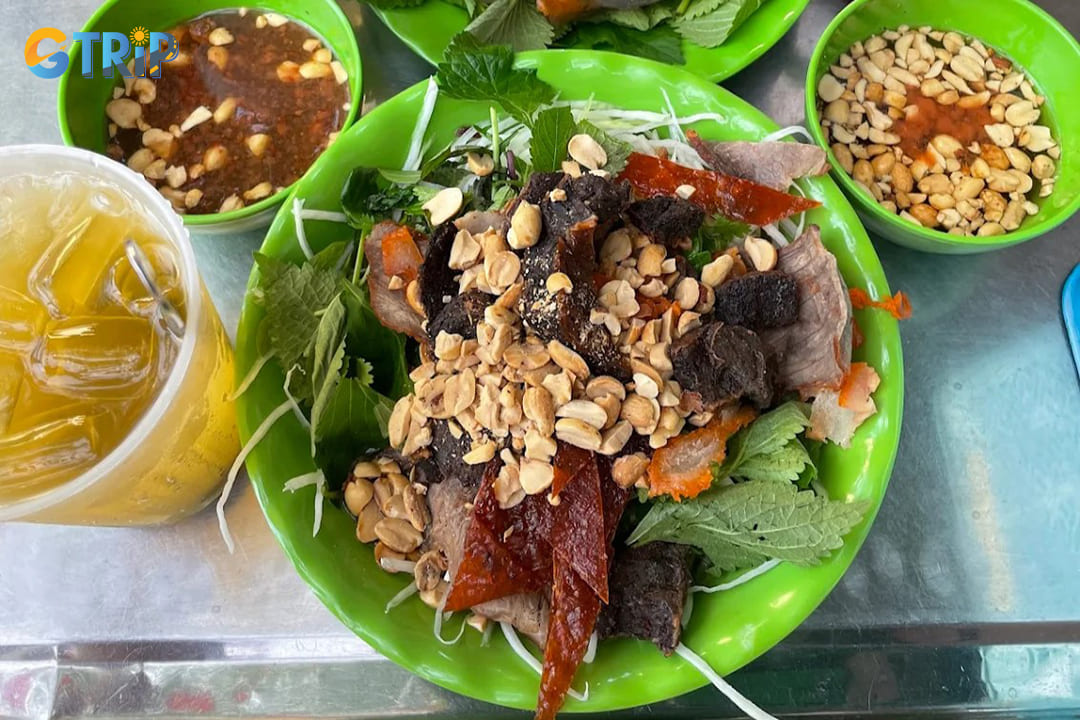
Nom bo kho is a vibrant and refreshing Vietnamese salad that perfectly balances sweet, sour, spicy, and savory flavors
25. O mai
O mai is a traditional Vietnamese preserved fruit snack deeply rooted in Hanoi's culinary culture. These sweet-sour treats are made by drying and preserving various fruits like plums, apricots, and kumquats with sugar, salt, ginger, and sometimes chili. Originally created as a way to preserve seasonal fruits, o mai has evolved into a beloved delicacy enjoyed year-round. Hanoi locals often nibble on these chewy, flavorful morsels between meals or serve them to guests as a welcoming gesture.
Flavor profile and varieties:
- Plum: The most classic variety, featuring a perfect balance of sweet, sour, and salty flavors
- Kumquat: Tangy and bright with a citrusy punch
- Apricot: Tender texture with a gentler sweet-sour profile
- Ginger: Spicy kick that pairs wonderfully with the sweetness of preserved fruits
- Tamarind: Deep, tangy flavor with a slightly sticky texture
Recommended places to eat you should try:
| Establishment | Location | Price range | Specialty |
|---|---|---|---|
| O Mai Ba Thu (Preserved Fruits) | 147 Ba Trieu Street, Hai Ba Trung Ward (147 Ba Trieu Street, Hai Ba Trung District, Hanoi) | 50,000 - 200,000 VND ($1.91 - $7.66) | Premium quality o mai with diverse fruit varieties and gift packaging available |
| O Mai Tien Thinh | 21 Hang Duong Street, Hoan Kiem Ward (21 Hang Duong Street, Hang Dao Ward, Hoan Kiem District, Hanoi) | About 15,000 VND (About $0.57) | Budget-friendly options with traditional recipes passed down through generations |
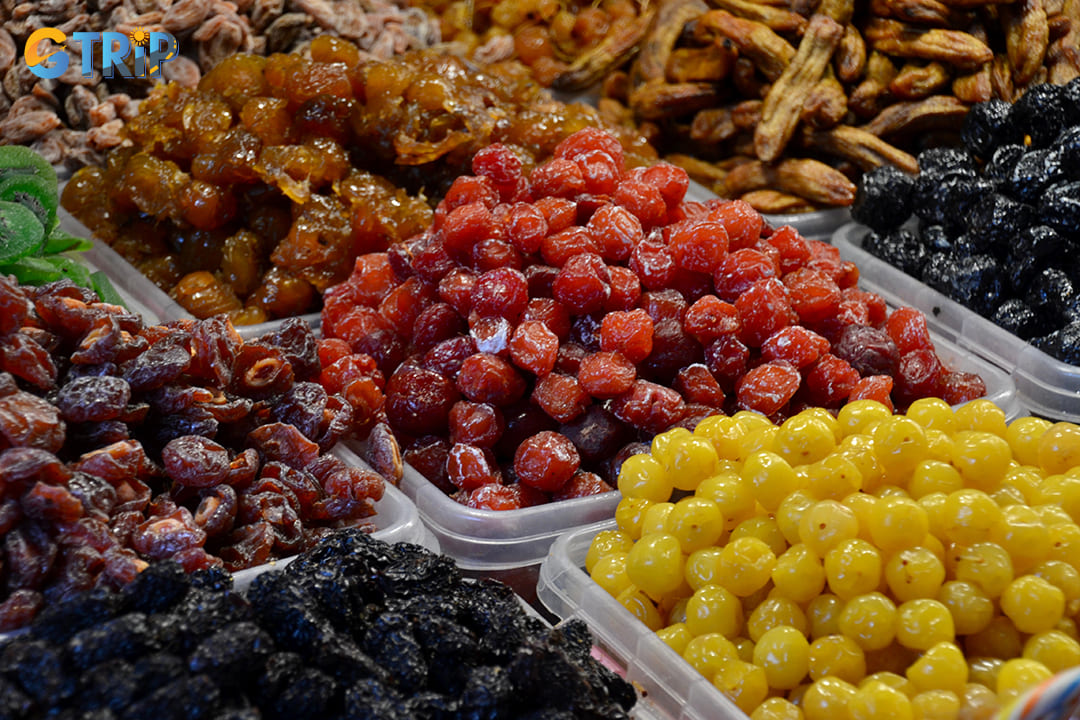
O mai is a traditional Vietnamese preserved fruit snack deeply rooted in Hanoi's culinary culture
Read more: The 15 Best Places to Buy Souvenirs in Hanoi
26. Trang Tien ice cream
For any traveler, sampling the iconic Trang Tien ice cream is a must on their list of things to do in Hanoi. Since the 1960s, this nostalgic yet affordable treat has delighted generations with distinctive flavors and a simple charm that reflects the capital's food culture. What makes it truly special is not just the taste but the experience, enjoying a cone while strolling the tree-lined boulevards near Hoan Kiem Lake and the Old Quarter, with the original shop still standing proudly on historic Trang Tien Street.
Where to buy Trang Tien ice cream:
| Location | Address | Price range |
|---|---|---|
| Original Trang Tien Store | 35 Trang Tien, Hoan Kiem Ward (35 Trang Tien, Hoan Kiem, Hanoi) | 10,000 - 30,000 VND ($0.38 - 1.15) |
| Xa Dan Branch | 259 Xa Dan, Dong Da Ward (259 Xa Dan, Nam Dong, Dong Da, Hanoi) | 10,000 - 30,000 VND ($0.38 - 1.15) |

The iconic Trang Tien ice cream is a beloved frozen treat that has delighted generations of locals since the 1960s
Read more: Discover what makes the Hanoi French Quarter a must-see destination.
27. Egg coffee
Egg coffee is a symbol of Hanoi's culinary creativity, blending bold Vietnamese coffee with a smooth, custard-like foam made from egg yolks, sugar, and condensed milk. Originating in the 1940s as a clever substitute when milk was scarce, this dessert-like drink has become a must-try, with some of the authentic egg coffee in Hanoi served at hidden cafes in the Old Quarter. For the full experience, try both hot and cold versions, hot egg coffee is kept warm in a bowl of hot water, while the cold version offers a refreshing twist for Hanoi’s humid summers. If you’re in the mood for something equally unique, coconut coffee is another Hanoi favorite worth exploring.
Recommended places to eat you should try:
| Venue | Address | Price range |
|---|---|---|
| Cafe Giang (Famous for Egg Coffee) | 39 Nguyen Huu Huan Street, Hoan Kiem Ward (39 Nguyen Huu Huan Street, Ly Thai To Ward, Hoan Kiem District, Hanoi) | Approx. 30,000 - 100,000 VND ($1.15 - 3.83) |
| Cafe Dinh | 13 Dinh Tien Hoang Street, Hoan Kiem Ward (13 Dinh Tien Hoang Street, Hang Trong Ward, Hoan Kiem District, Hanoi) | Approx. 30,000 - 100,000 VND ($1.15 - 3.83) |
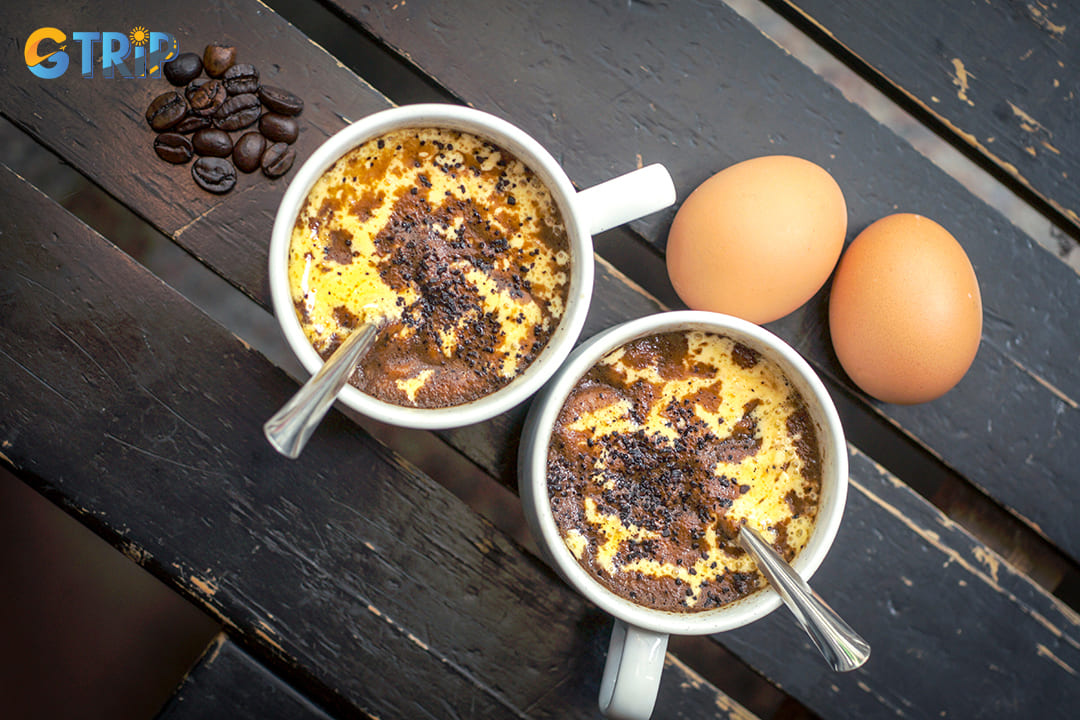
Egg coffee is a decadent beverage combining rich Vietnamese coffee with a creamy, custard-like topping made from whisked egg yolks, sugar, and condensed milk
28. Tra chanh (Lemon tea)
Tra chanh, or Vietnamese lemon tea, is a simple yet iconic street drink that blends green tea with lemon, sugar, and ice for a refreshing balance of sweet, sour, and slightly bitter flavors. Loved especially by Hanoi’s younger generations, it’s not just the taste but the sidewalk experience that makes it special, most famously around St. Joseph's Cathedra, where people gather on tiny stools to chat, people-watch, and escape the city’s heat. Though it seems basic, tra chanh requires precision in preparation and has inspired modern twists with honey, mint, or salt, making it both a cooling refreshment and a cultural staple of Hanoi.
Where to find the best tra chanh in Hanoi:
| Venue | Address | Price range | Special features |
|---|---|---|---|
| Tra chanh sidewalk | Sidewalk eateries near St. Joseph's Cathedral in Hanoi | 15,000-25,000 VND ($0.60-$1.00) | Authentic street experience with tiny plastic stools; best for people-watching and experiencing local culture |
| Tra chanh Layla (Main Branch) | 138 Tran Dai Nghia Street, Bach Mai Ward, Hanoi (138 Tran Dai Nghia Street, Dong Tam Ward, Hai Ba Trung District, Hanoi) | About 20,000 VND ($0.77) | Modern setting with consistent quality; popular among students and young professionals |
| Tra chanh Layla (Second Branch) | 1 Van Ho 2 Street, Hai Ba Trung Ward, Hanoi ( 1 Van Ho 2 Street, Hai Ba Trung District, Hanoi) | About 20,000 VND ($0.77) | Air-conditioned space with the same quality drinks as the main branch |

Tra chanh, or Vietnamese lemon tea, is a beloved street beverage that has become an integral part of Hanoi's social culture, especially for younger generations
29. Che (Sweet soup)
Che is Vietnam's beloved answer to dessert, a diverse family of sweet soups and puddings that showcase the incredible variety of textures and flavors in Vietnamese cuisine. Unlike Western desserts, che balances sweetness with unique ingredients like beans, jellies, fruits, and glutinous rice. In Hanoi, che shops offer dozens of variations, served either warm or cold depending on the season, making it a year-round favorite for locals seeking a sweet respite from the city's bustling streets.
Popular che varieties in Hanoi:
- Che ba ba: "Three kinds" dessert with taro, cassava, and mung beans in coconut milk
- Che dau xanh: Mung bean sweet soup, often topped with coconut cream
- Che thap cam: "Mixed che" with various jellies, fruits, and beans
- Che buoi: Pomelo sweet soup with a delightful citrus note
- Che sen: Lotus seed sweet soup, considered a refined Hanoi specialty
Recommended places to eat you should try:
| Shop Name | Address | Price range |
|---|---|---|
| Che Go | No. 9, Tran Phu, Ba Dinh Ward, Hanoi (No. 9, Tran Phu, Ba Dinh, Hanoi) | 26,000 - 36,000 VND ($1.00 - $1.38) |
| Che Xoan | No. 29 Hang Giay, Hoan Kiem Ward, Hanoi (No. 29 Hang Giay, Hoan Kiem District, Hanoi) | 20,000 - 35,000 VND ($0.77 - $1.34) |
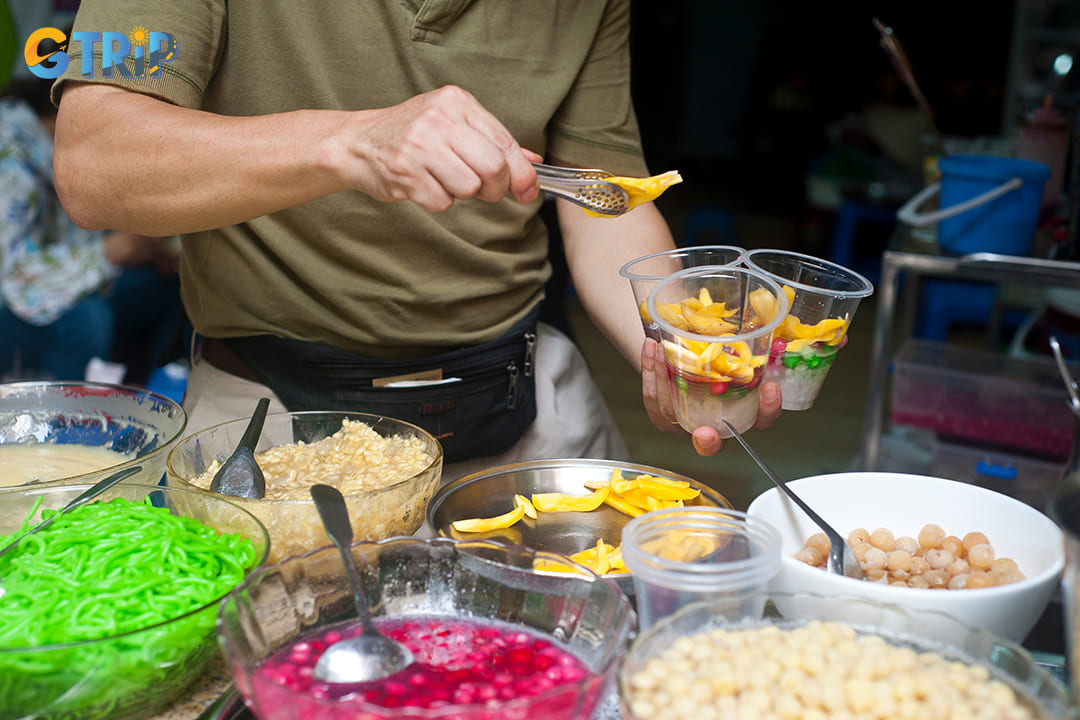
Che is Vietnam's beloved answer to dessert, a diverse family of sweet soups and puddings that showcase the incredible variety of textures and flavors in Vietnamese cuisine
Read more: Famous Desserts in Hanoi to Try - Sweet Treats You Shouldn’t Miss
30. Seasonal fruits in Hanoi
Hanoi's vibrant food scene extends beyond its famous savory dishes to include an impressive array of seasonal fruits that change throughout the year. As Vietnam's capital experiences distinct seasons, different fruits reach their peak at various times, offering visitors a chance to taste authentically local produce. These seasonal treasures can be found in traditional markets and modern supermarkets alike, providing a refreshing complement to Hanoi's rich culinary landscape.
| Season | Months | Seasonal fruits | Characteristics |
|---|---|---|---|
| Spring | Jan-Mar | Moc Chau strawberries, local apples | Sweet-tart strawberries grown in the cooler highland climate of Moc Chau; crisp local apples with balanced sweetness |
| Summer | Apr-Jun | Luc Ngan lychees, Lao Cai/Moc Chau plums, dau da (pine berries) | Lychees with translucent white flesh and sweet floral flavor; tart-sweet plums; unique pine berries with distinctive aroma |
| Mid-Summer | Jul-Aug | Hung Yen longans, Lao Cai/Moc Chau plums, dau da | Sweet, fragrant longans with brown shells and juicy translucent flesh; late-season plums; refreshing pine berries |
| Fall | Sep-Nov | Dien pomelos, Xuan Dinh sapodillas, custard apples | Large, sweet-tart pomelos with thick skin; soft, sweet sapodillas; creamy custard apples with sweet flesh |
| Winter | Dec | Dien pomelos, Moc Chau strawberries | Late-season pomelos, early strawberries harvested from highland farms |
Where to buy seasonal fruits in Hanoi:
- Traditional markets
- Dong Xuan Market: Largest traditional market with extensive fruit sections
- Quang Ba Flower Market: Also sells premium fruits, especially in early mornings
- Hom Market: Known for quality and variety of regional fruits
- Modern retailers
- Co-opmart: Reliable selection of seasonal fruits with stable pricing
- VinMart: High-quality fruits, often with regional labeling
- BRG Mart: Premium imported and local fruits
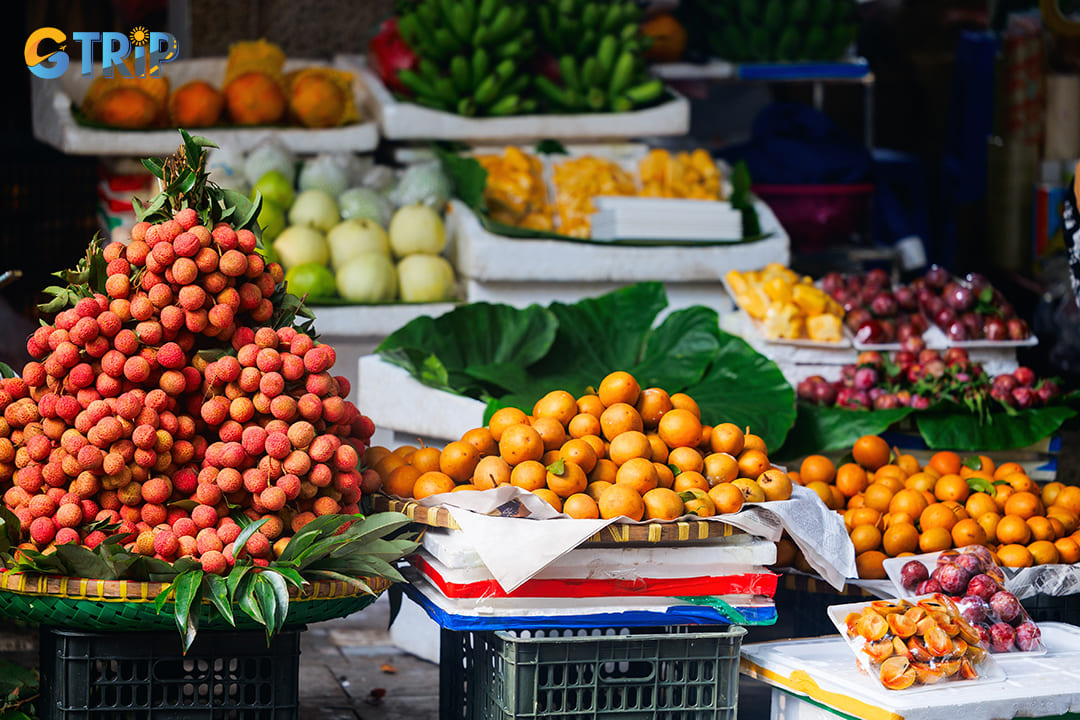
Hanoi's vibrant food scene extends beyond its famous savory dishes to include an impressive array of seasonal fruits that change throughout the year
Read more:
Your journey through the famous foods in Hanoi has given you more than just a list of dishes, it’s a true map to the city’s soul. Every bowl of pho and every bite of bun cha tells a story of history and tradition, connecting you deeply with local life. So, grab a little plastic stool, point to something that looks tempting, and create your own unforgettable food memories. And when you’re ready to go beyond Hanoi, let GTrip be your trusted guide. With our curated Vietnam package tours, you can not only book Hanoi food tours to savor these 30 must-try dishes, but also continue your culinary adventure across the country.

